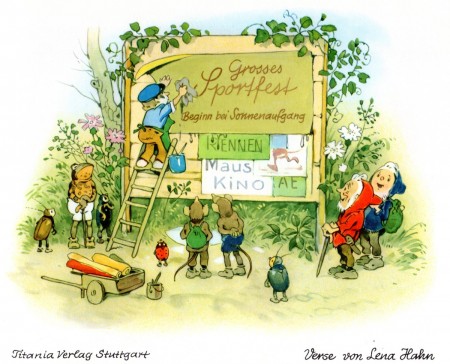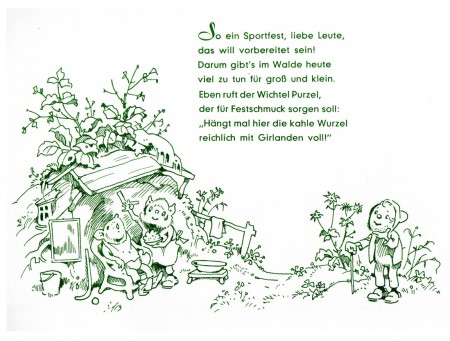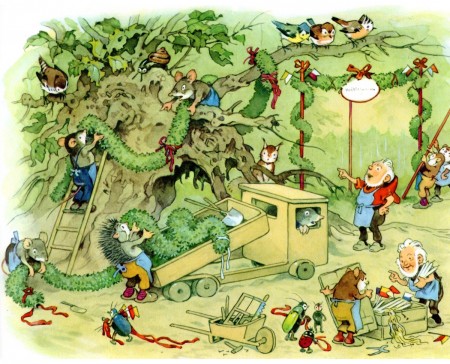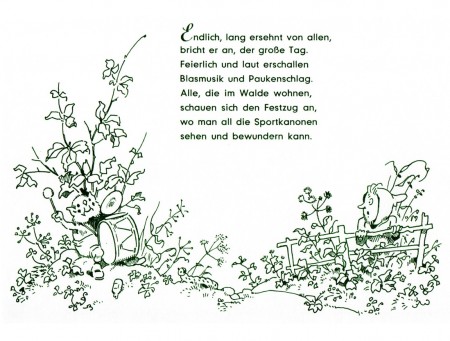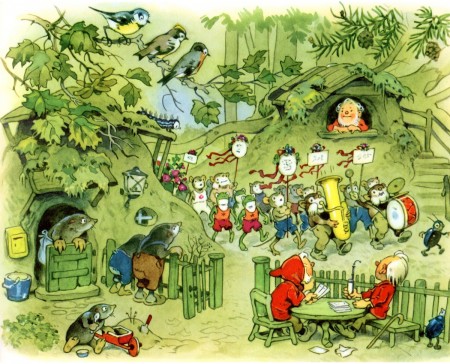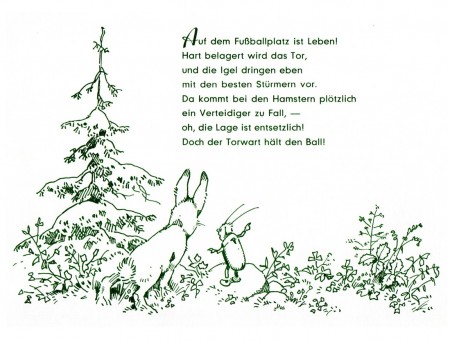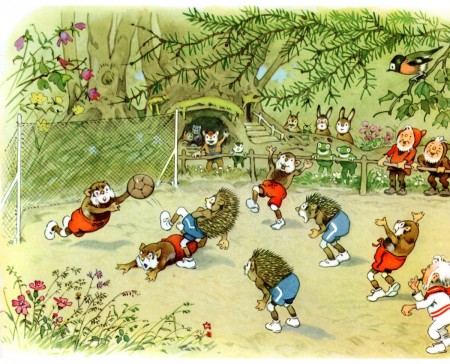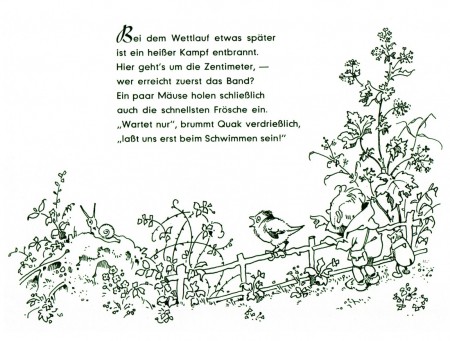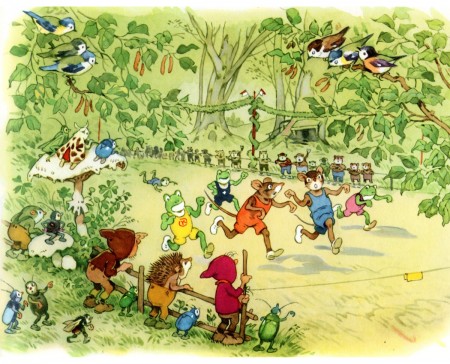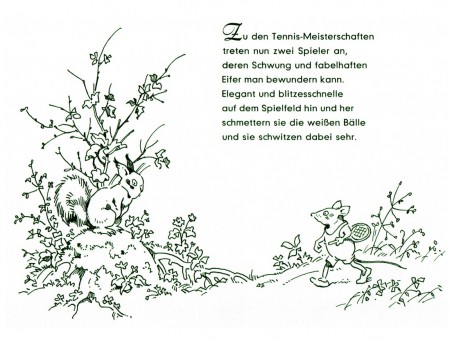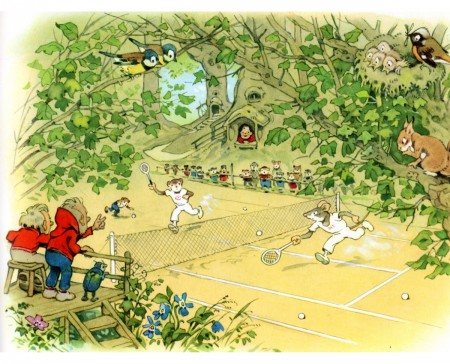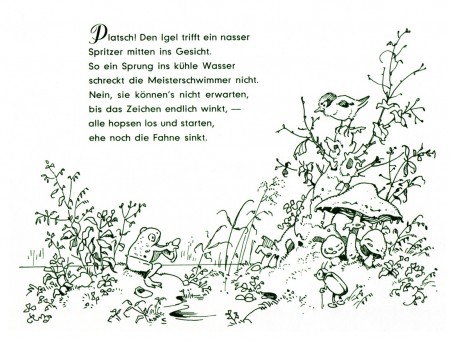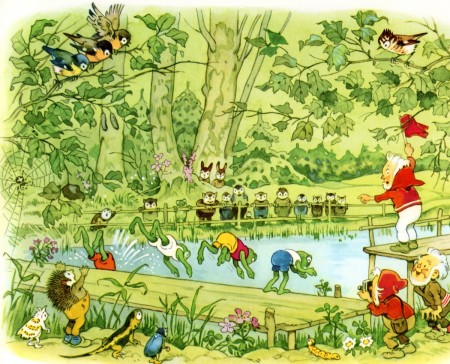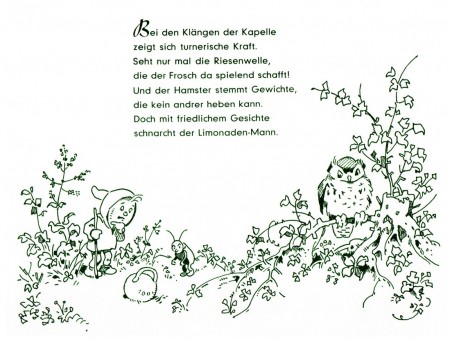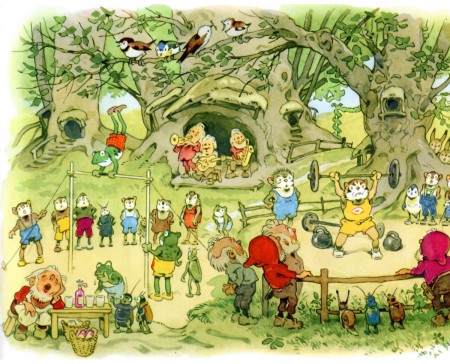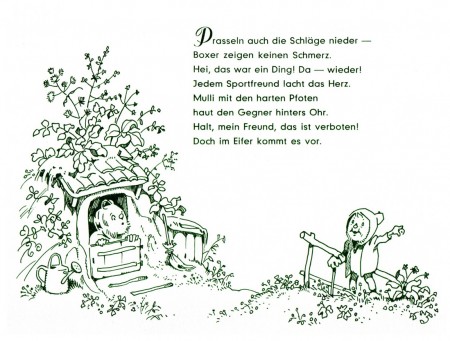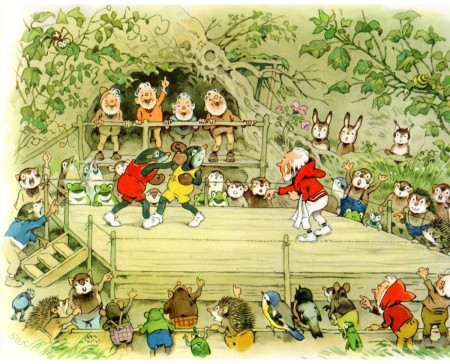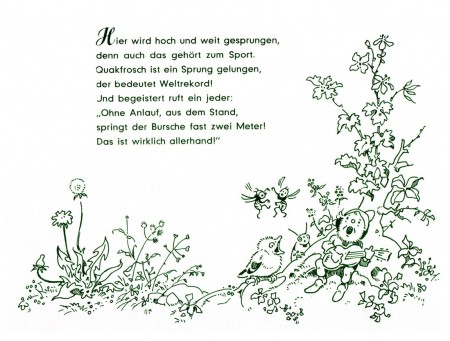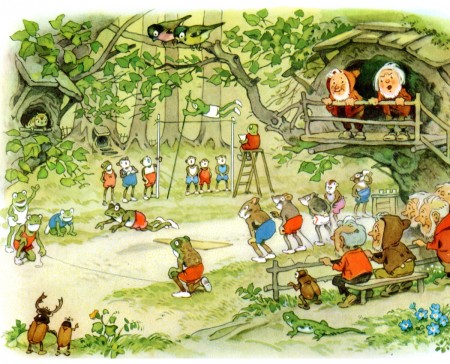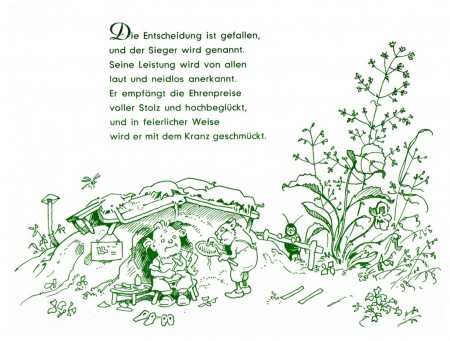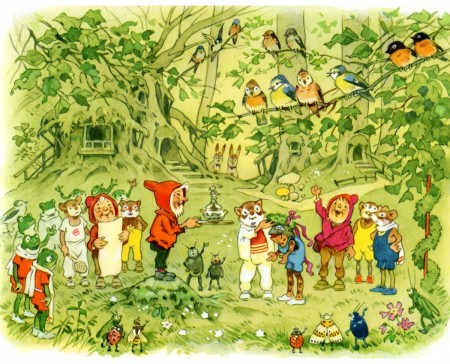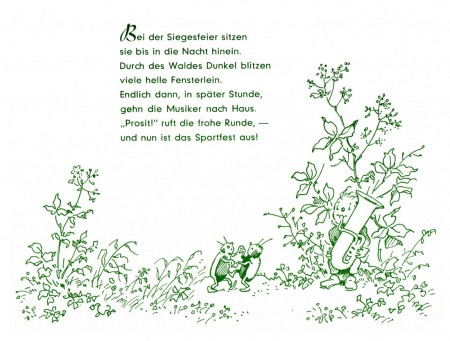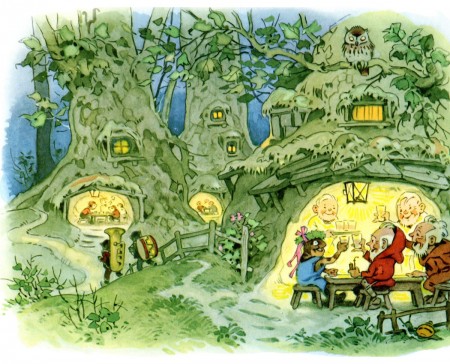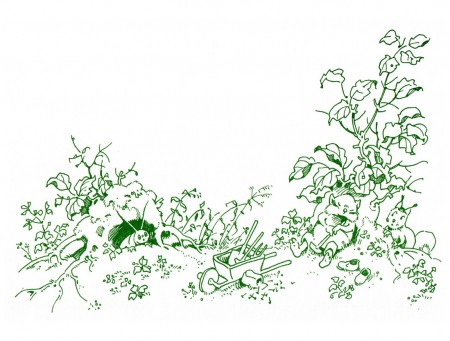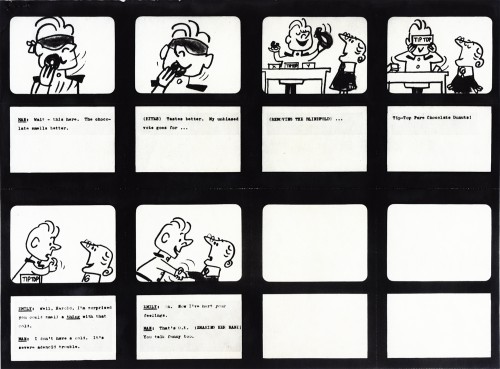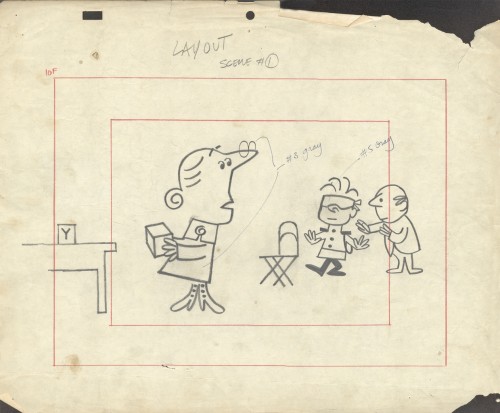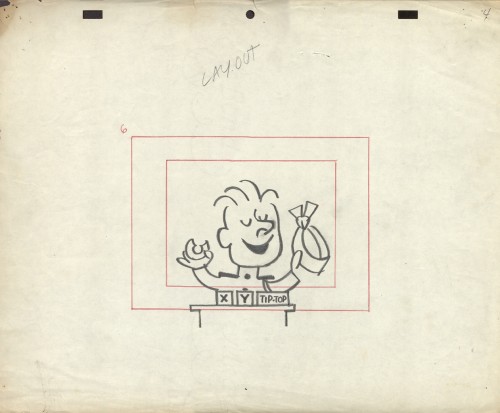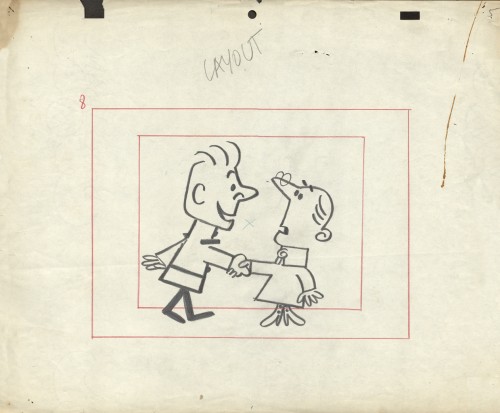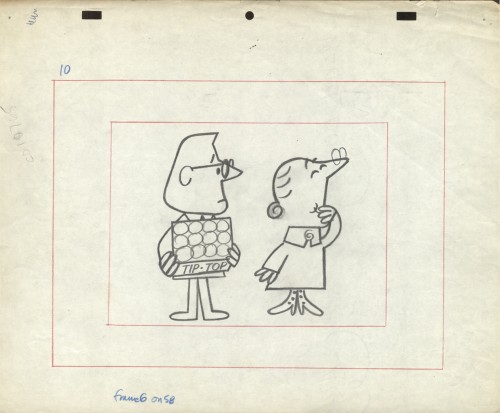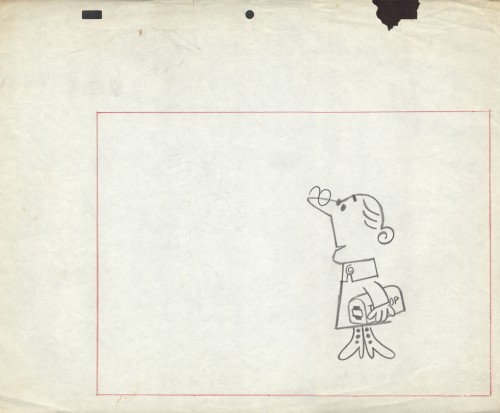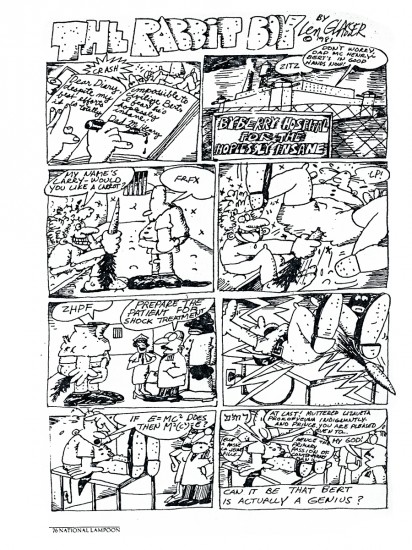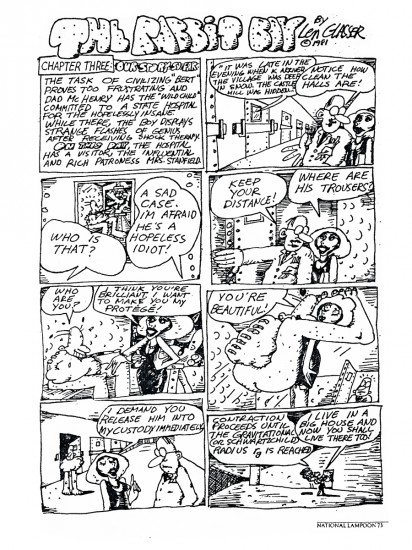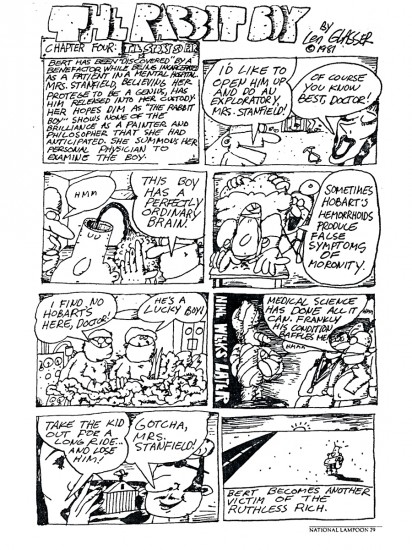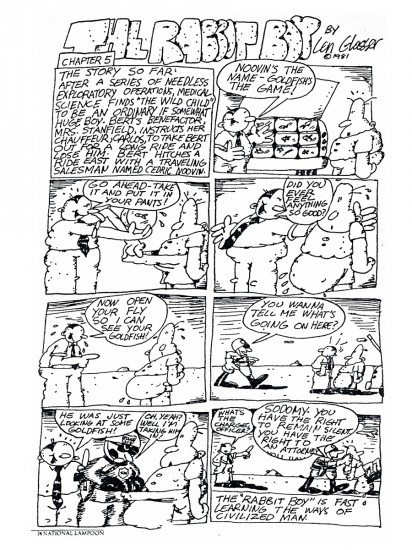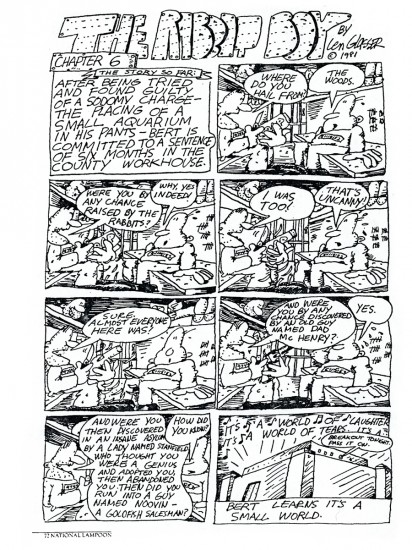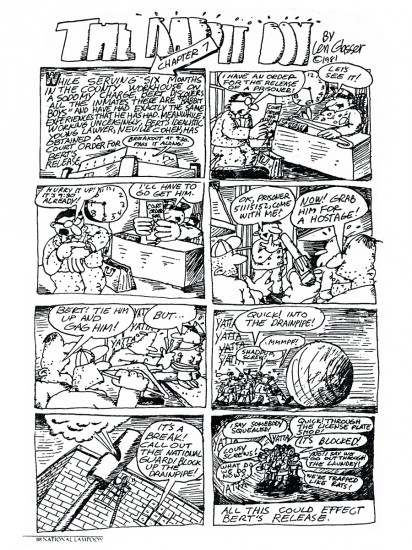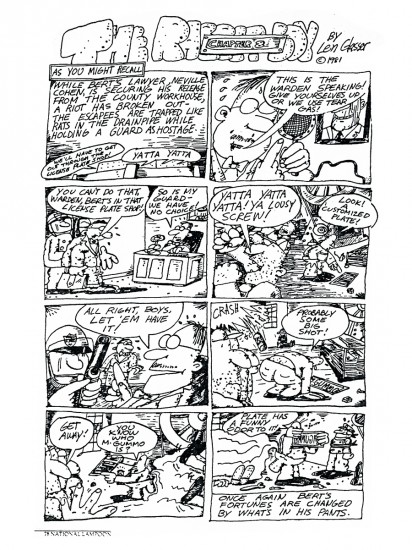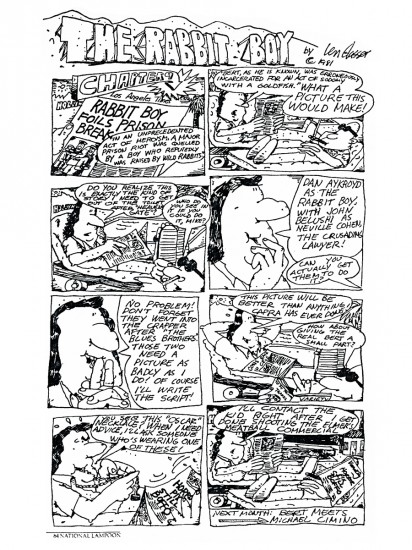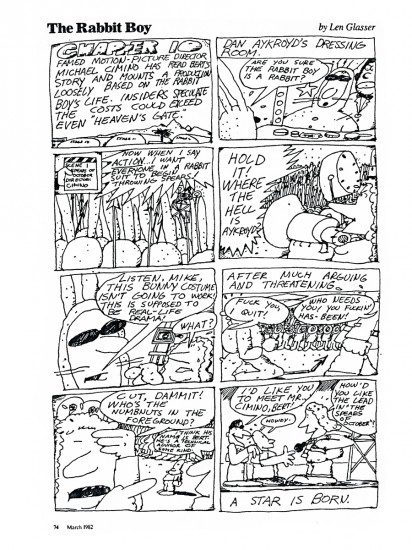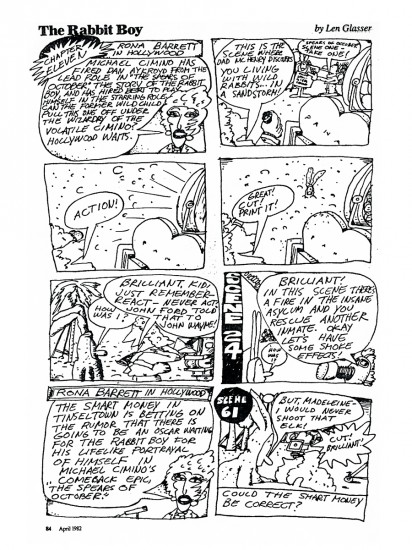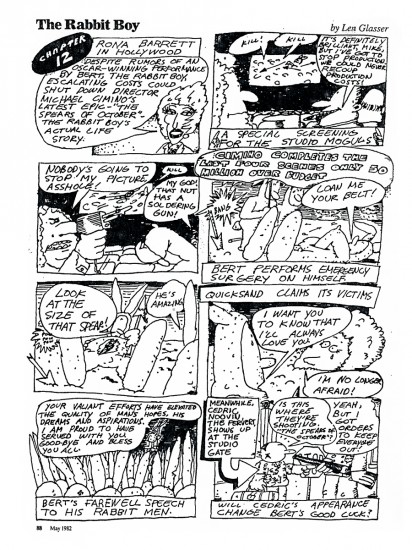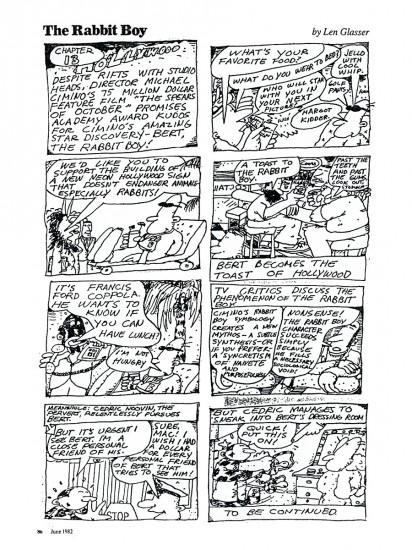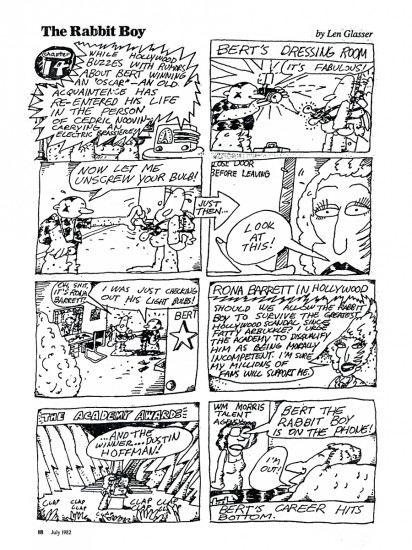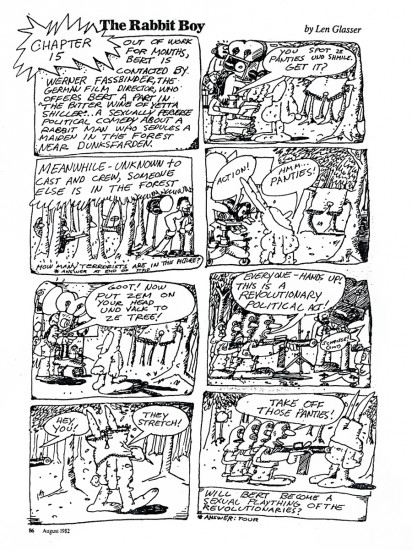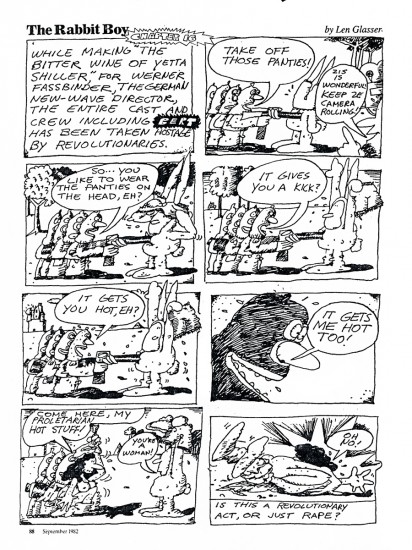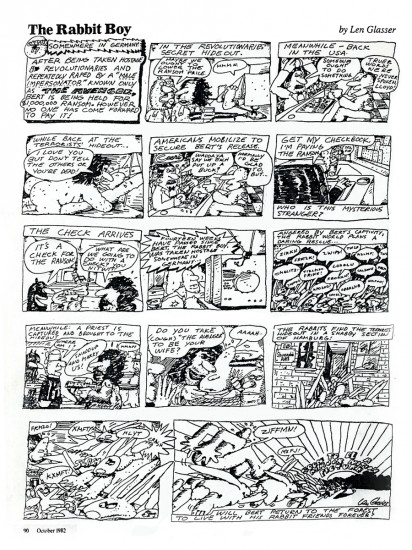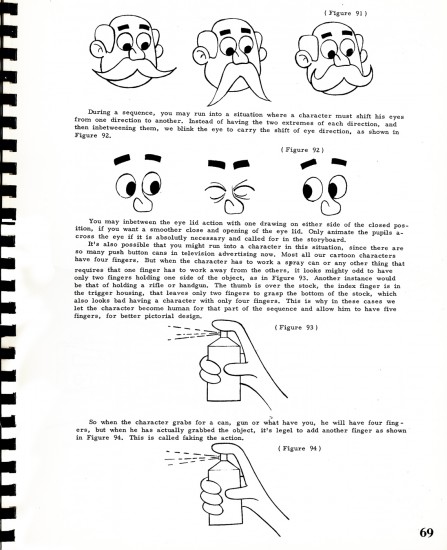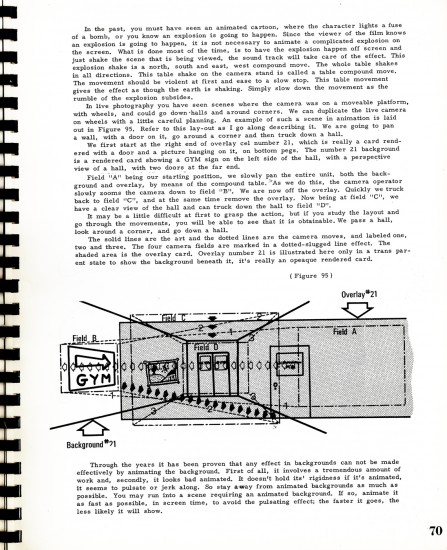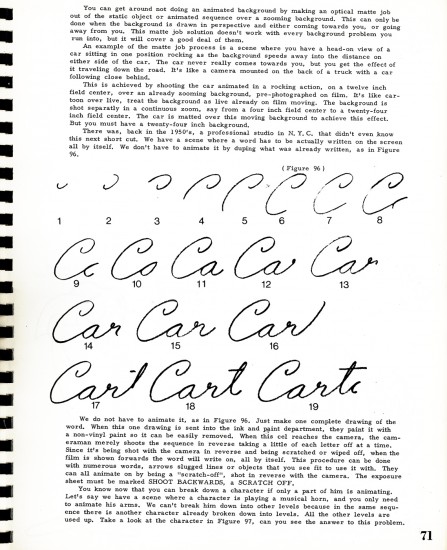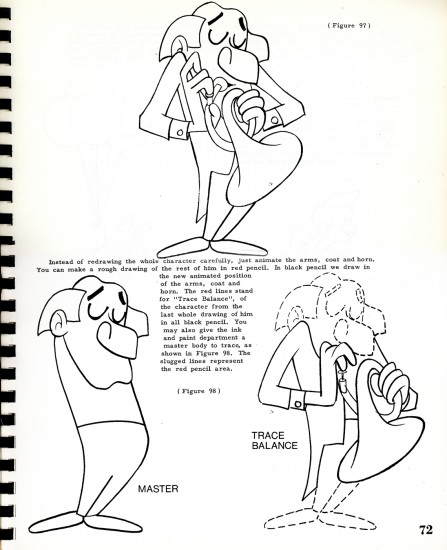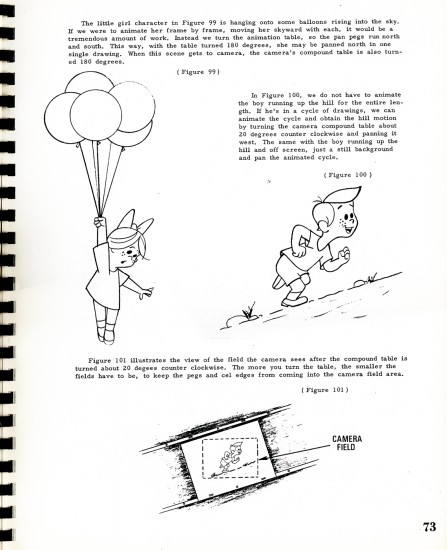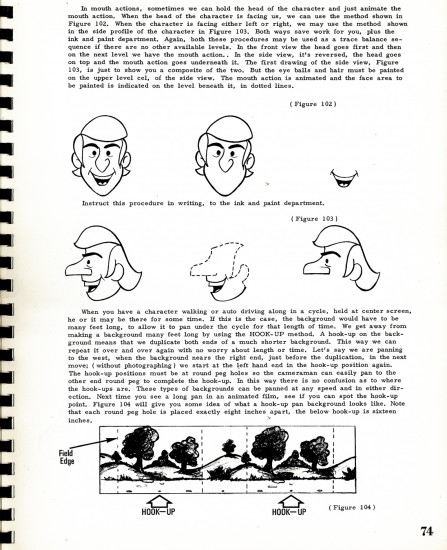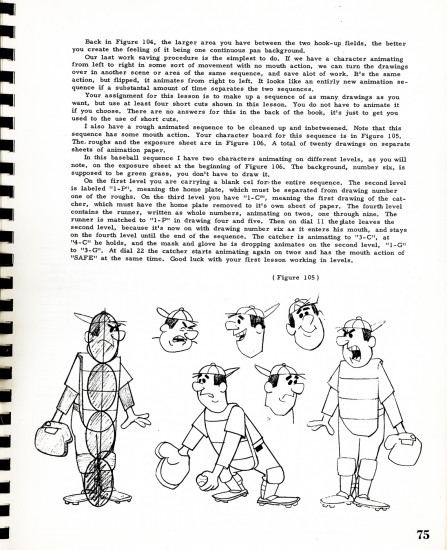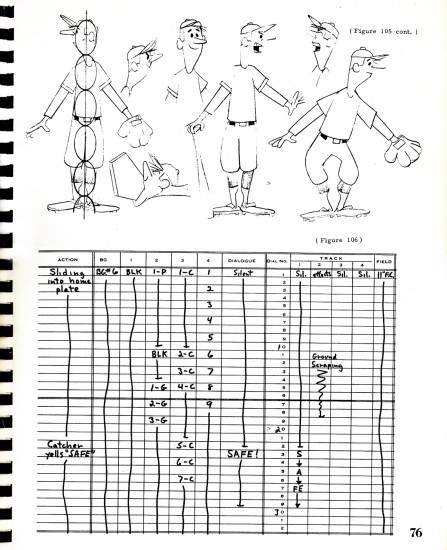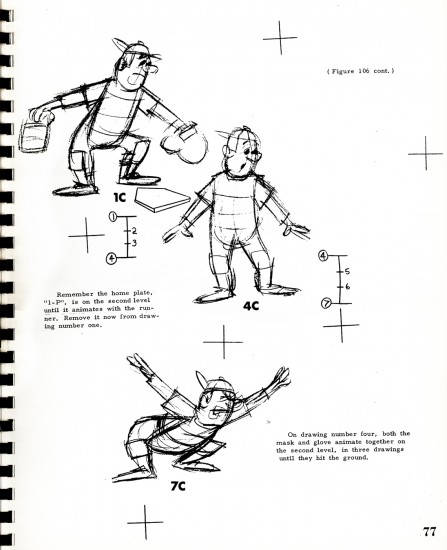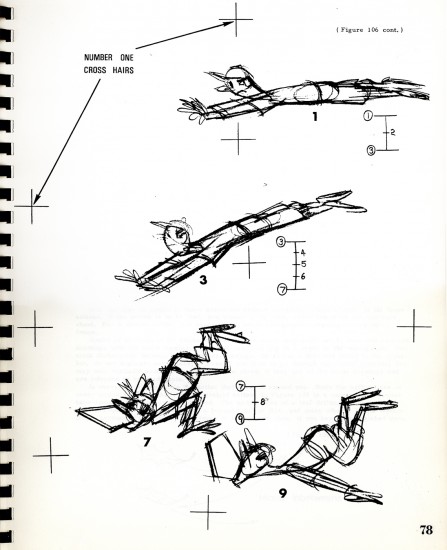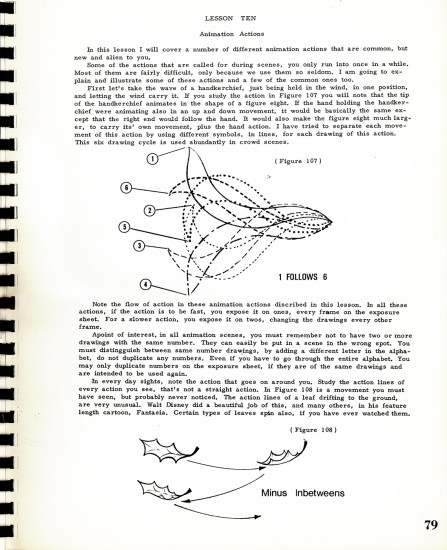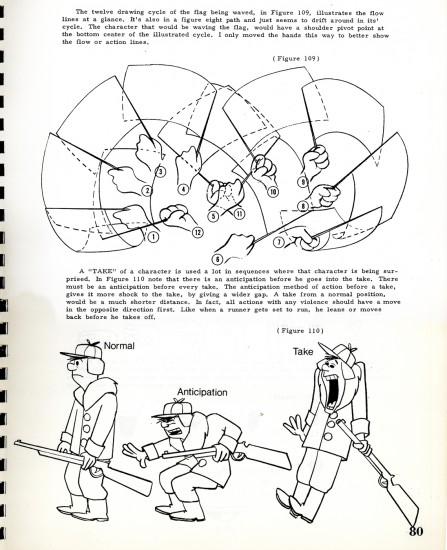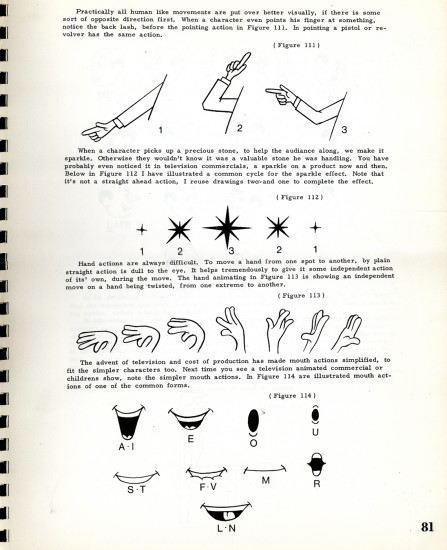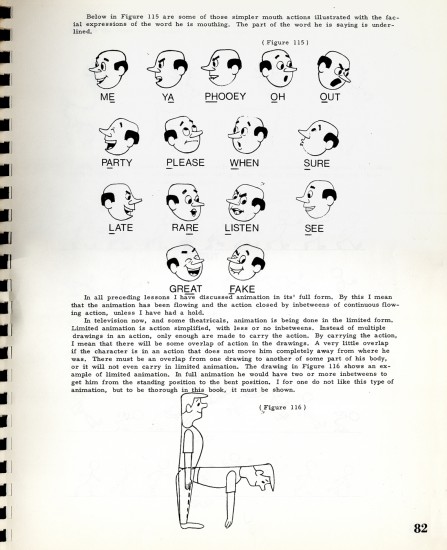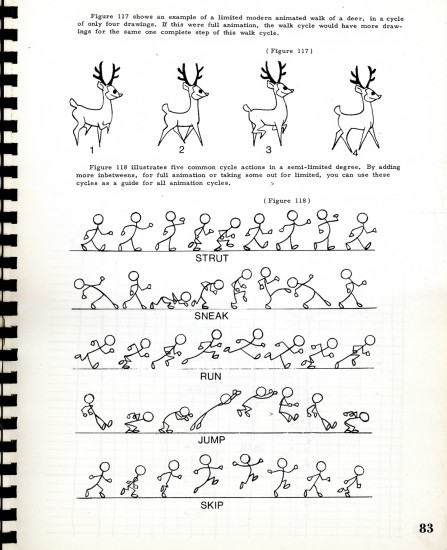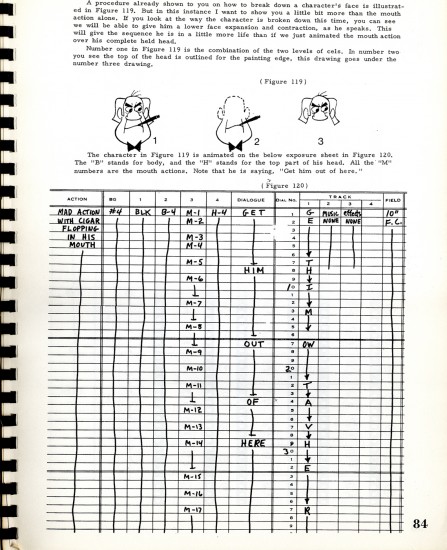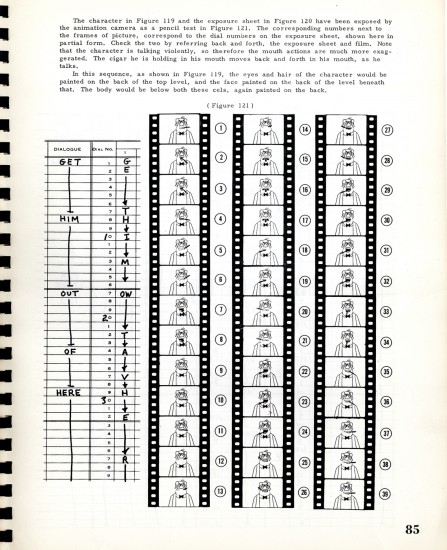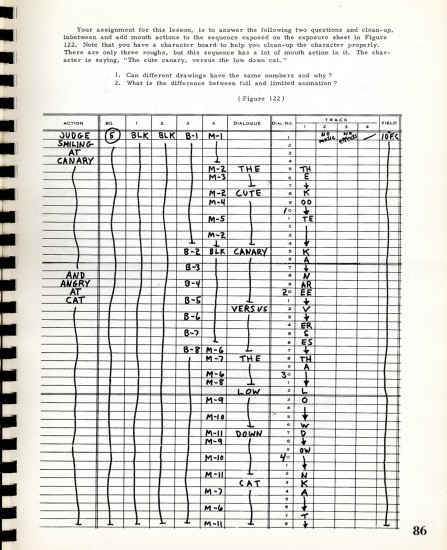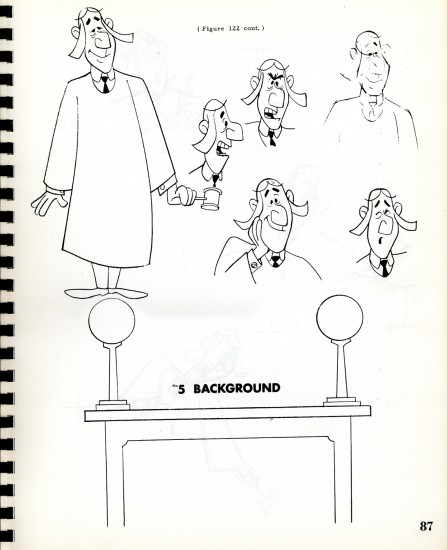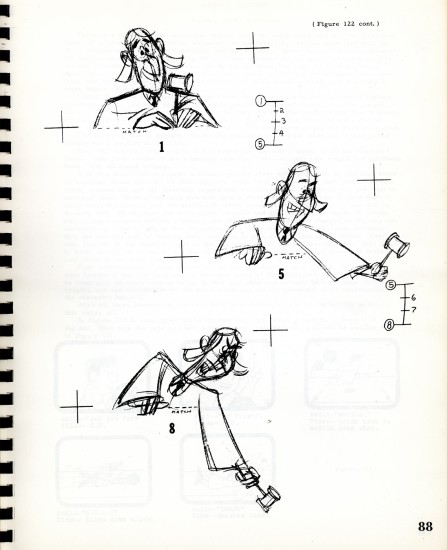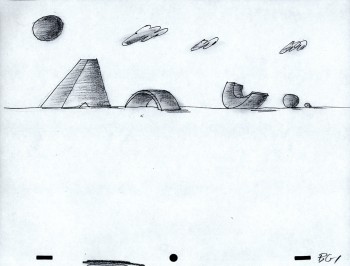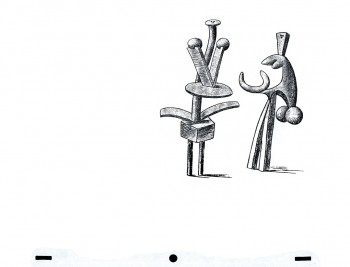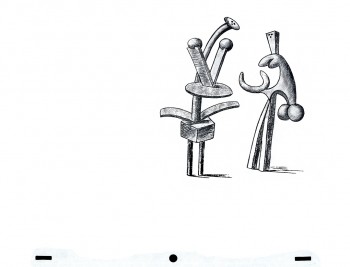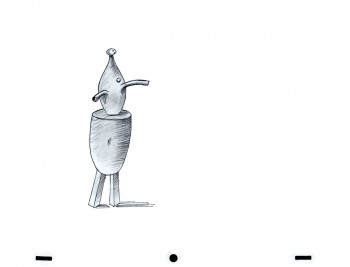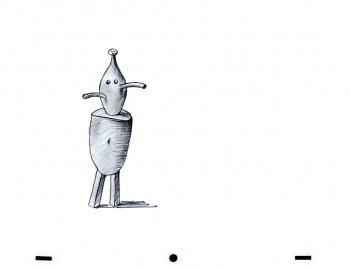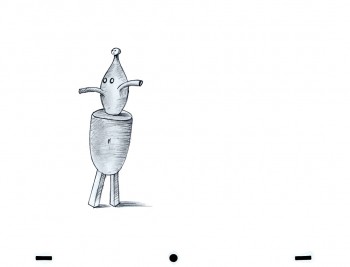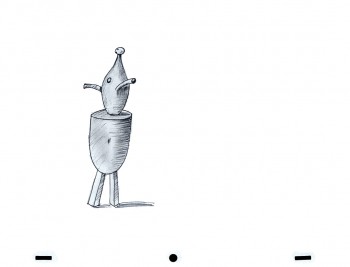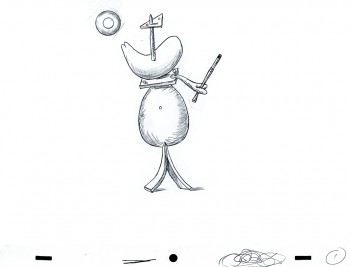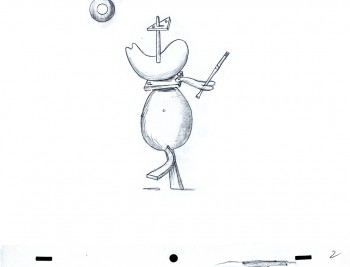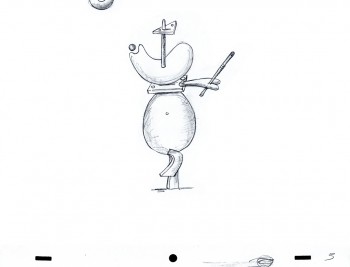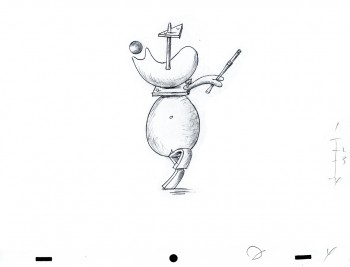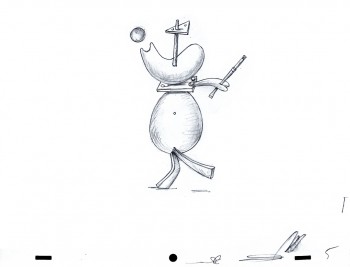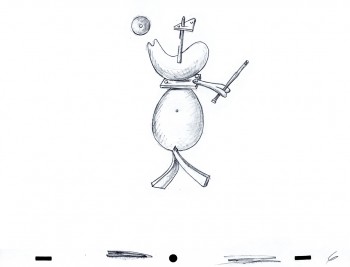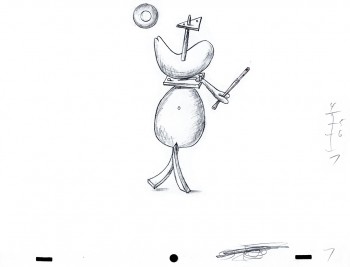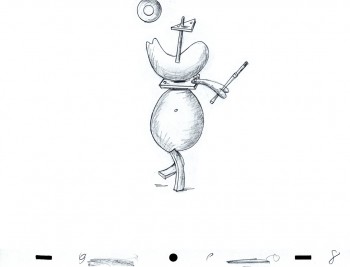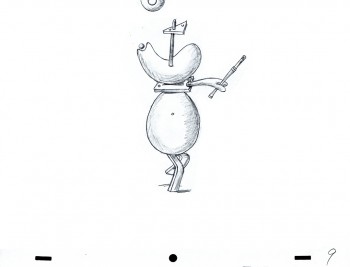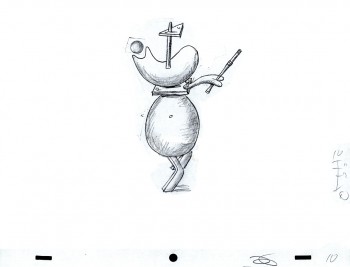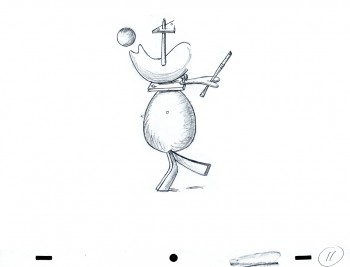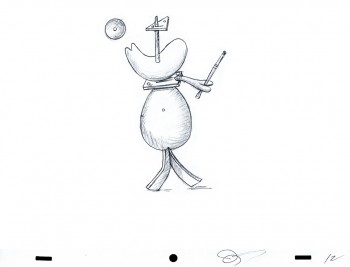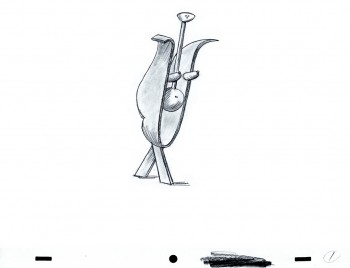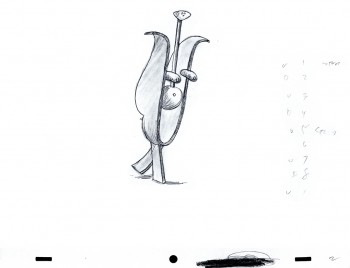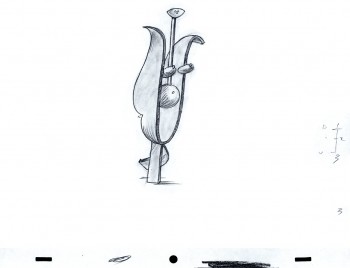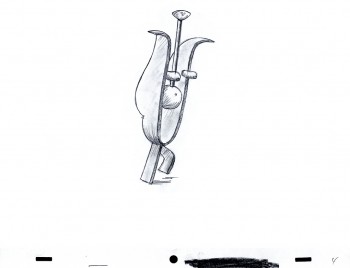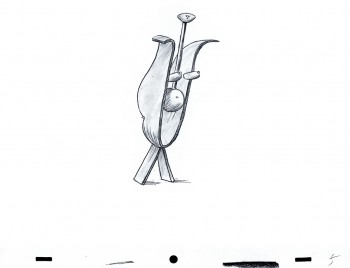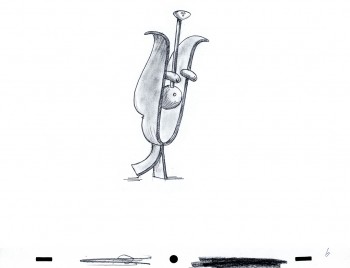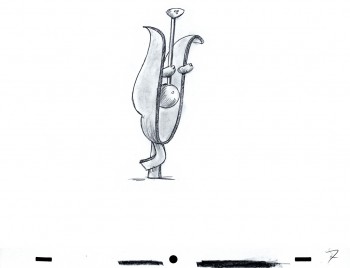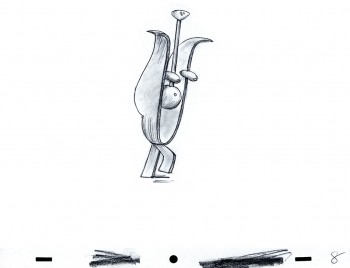Monthly ArchiveJanuary 2013
Bill Peckmann &Books &Illustration 11 Jan 2013 07:09 am
Baumgarten’s Sports
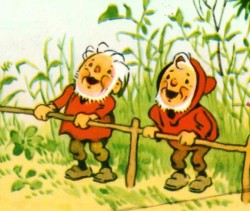 - Bill Peckmann has given us a wide assortment of beautiful books by Fritz Baumgarten. The illustrator has written many books built around a world of creatures and their environs that he’s created. His style is so affectingly attractive with the very rounded turns that we almost miss the beautiful inking and the fine watercolor techniques. The books are all very different, but there is a bit of a sameness to the work in that we don’t stray from the woods where the creatures – the small animals and dwarfs – make their homes.
- Bill Peckmann has given us a wide assortment of beautiful books by Fritz Baumgarten. The illustrator has written many books built around a world of creatures and their environs that he’s created. His style is so affectingly attractive with the very rounded turns that we almost miss the beautiful inking and the fine watercolor techniques. The books are all very different, but there is a bit of a sameness to the work in that we don’t stray from the woods where the creatures – the small animals and dwarfs – make their homes.
This book takes a different turn and gives Baumgarten a chance for some fun. Sportfest im Walde is obvious in its subject. The dwares and animals compete with a number of sports. From tennis to racing to boxing, activities abound.
I hope you enjoy it; I do. It’s a world I wouldn’t have otherwise seen, and I wish there’d been an animated version somewhere along the way. When Goebbels set up an animation studio to promote all things German, he should have animated hese books. They would have been wonderful as a series. They still are.
Many thanks, yet again, to Bill for the scans and the book, itself.
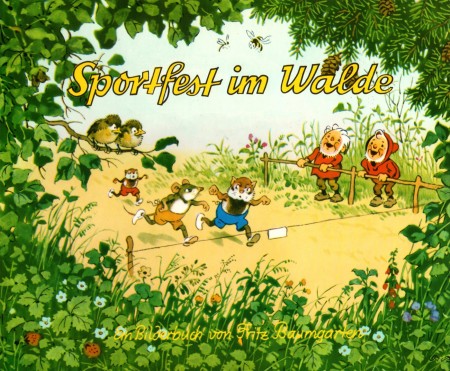
The book’s cover
Animation Artifacts &commercial animation &Layout & Design 10 Jan 2013 06:25 am
Emily Tipp Rerun
- Originally, after Vince Cafarelli had died, I was shown the boxes and portfolios full of artwork that Vince had very briefly and casually discussed with me for years. What I thought were a couple of drawings, ended up being a lot of brilliant work beautifully contained by Vinnie and his partner Candy Kugel, over the many ears they had their studio. It was work – meaning drawings, sketches, layouts and animation – that Vinnie had held on to and in some cases preserved because he knew it was valuable (not financially, but historically).
In the not-too-distant past (6/27/12 and 10/24/12), I posted material about an Emily Tipp commercial for Tip Top Bread. This spot, like all of those of the series, was well designed and animated and stood out among other spots on TV. It was commercial cartoon animation at its best during the 60s. Margaret Hamilton, memorably, the Wicked Witch of the West from The Wizard of Oz, provided the voice for Emily!
The problem for me was the disorganization. So little of it was labelled or attached to any others that were gathered in those boxes. So I started digging in and organizing while at the same time pulling art for display on this blog. What happened was pretty much what I expected. Some things got mislabeled and other items were separated from art which they should have been attached to. Here we have a prime example. Emily Tipp.
Gathered in one group/box were some of the layouts for this typical TipTop Bread spot. We’d already assembled some of the drawings that belonged together despite the fact that the were found in separate boxes representing different studios. It turns out that some work that was credited to Kim-Gifford Studio (the laouts below) actually were done by Elliot-Graham-Goulding.
So here, we have some story boards to connect with some layouts. Compare and contrast and enjoy.
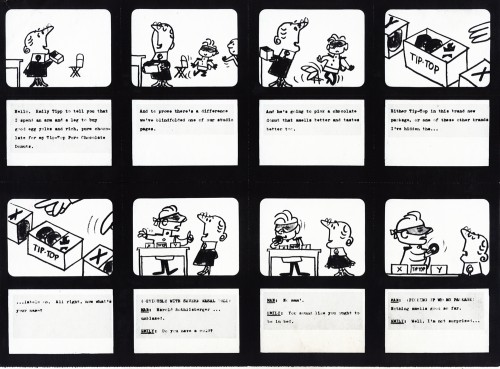 1
1
To see some of the Emily Tipp spots go here
at the Buzzco website.
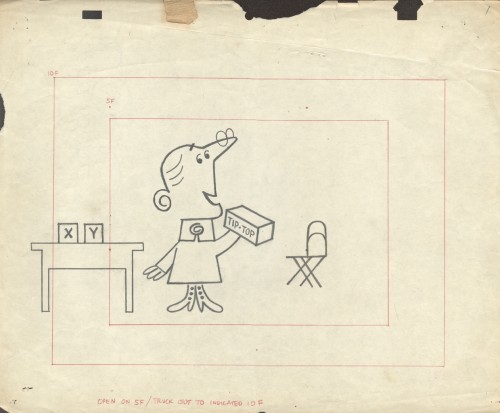 1
1
Comic Art &Illustration &Miyazaki 09 Jan 2013 06:39 am
Len Glasser’s Rabbit Boy
- In 1981 and 1982, designer Len Glasser did a comic strip which appeared in the National Lampoon Magazine. This was a full page strip that appeared once a mnth. I’m not sure how many episodes there were of the strip, but I have copies of 17 of them. Mr. Glasser’s style seems well suited for a strip, and the writing is a large part of it. I hope you enjoy, Rabbit Boy.
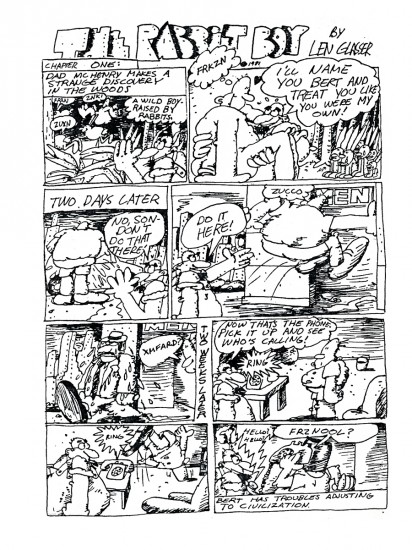 1
1
Commentary 08 Jan 2013 06:41 am
Some Movies I’ve Thought About
- The feature length cut of The Cobbler and the Thief as was assembled by the remarkable Garrett Gilchrist can be found on line:
A beautiful copy of the workprint.
Let me tell you some thoughts I have about this incredible movie.
It’s sad watching it again. I had only the slightest of involvement on the film. It touched my life more than I touched it. I’d seen the documentary on PBS back in the early sixties. The Creative Person: Richard WIlliams. I was impressed. I scoured the newspapers and any other media searching for words about this film or its mad director, Dick Williams. His London studio had sent me a packet they produced full of publicity articles on papers slightly larger than 8 1/2 x 11. I read and reread all those non-bound pages, and they grew dog eared. Williams, his studio and his film was my obsession for a while. It seemed to be the only place where real animation was being done anymore, back in the sixties,.
John Hubley was my hero, and his studio hired me in NYC. It was supposed to be a three day line of employment, but the job ended up lasting the last six years of John’s life.
On the second day there, I met Tissa David. During our first conversation, maybe 15 minutes long, I told her that it was my intention to eventually leave New York to work in London for Dick Williams. (We’d written, and Dick said that he’d see me the next time he came through NY.) On telling Tissa this story, after she had just introduced herself by saying I had done the worst inbetweens she’d ever seen, she – in the most sincere and pleading voice I’d heard – said, “Please don’t leave America. We need you here, animation needs you here.” Or it was certainly something very much to that effect.
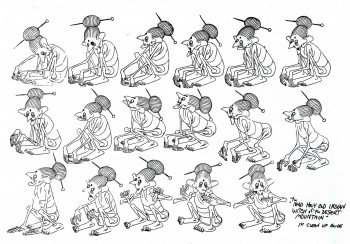 The story never quite worked, the Cobbler’s story never quite worked. I remember once reading the script and thinking it’s a feature length Road Runner cartoon. There was too much madcap humor at the Thief’s expense. I may have been wrong. The film seems to have been made to challenge animators. It’s difficult to animate the old Holy, Mad witch, but if you put her on a swinging basket while she talks, it’s even more difficult. Two uneven and oddly attached ropes makes it an extraordinarily difficult challenge. The weight and balance become everything. That’s what’s been done. It’s that way with every scene or character or motion in the film. If the challenge to the character in the scene can be made more difficult, then do it. Grim Natwick loved the challenge, helped develop the character, and Dick accomplished it.
The story never quite worked, the Cobbler’s story never quite worked. I remember once reading the script and thinking it’s a feature length Road Runner cartoon. There was too much madcap humor at the Thief’s expense. I may have been wrong. The film seems to have been made to challenge animators. It’s difficult to animate the old Holy, Mad witch, but if you put her on a swinging basket while she talks, it’s even more difficult. Two uneven and oddly attached ropes makes it an extraordinarily difficult challenge. The weight and balance become everything. That’s what’s been done. It’s that way with every scene or character or motion in the film. If the challenge to the character in the scene can be made more difficult, then do it. Grim Natwick loved the challenge, helped develop the character, and Dick accomplished it.
This, of course, is not only fine, it’s fun for the very talented animator – animators such as Dick Williams – but the problem is that it doesn’t really advance the story. The animation for this film is beyond complicated and done so extraordinarily well. The more you know about it, the more you realize how hard it was to do and how well it was done.
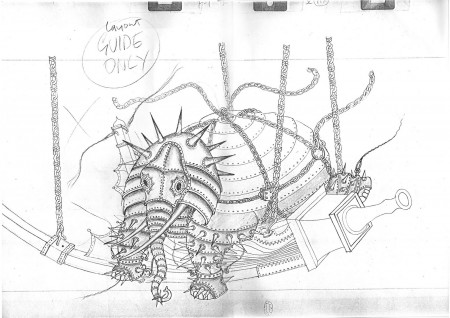
A couple of Roy Naisbit War Machines
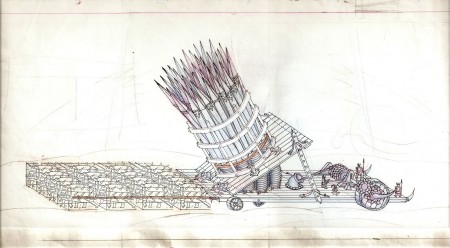
Roy was one of the great Artists Dick introduced to animation.
Today, of course, we have computers that could animate most of the objects in this film. I’m not sure the “War Machine” would be any better, but it would have taken fewer man-hours. All that glorious drawing, Ink & Pt coloring and design was dependent on the perfect timing. The animation. Perhaps in time a computer would’ve gotten it.
In the first third of the film, there are two lovely scenes animated by Tissa David. Both are pencil tests of the princess, Princess Yum-Yum, in the bath. We’re looking over her shoulder and she looks back toward us, where we are off screen. The hair is up in her scenes, appropriate to a bath. In between there’s another pencil test scene of the princess with her hair down, and it no longer looks like the same character. The art is flatter. Tissa’s princess was voluptuous. As a matter of fact, her princess was two. Two mirroring twins who echoed each other in animation (anything to challenge the animator). Princesses Yum Yum and Mee-Mee. At the suggestion of the brilliant Jake Eberts, one of the two princesses was dropped. Mee Mee.
Tissa in working for Dick out of her NY apartment had purchased a Lyon-Lamb machine. Large and a bit cumbersome, this video machine came in the pre-computer days and was wholly a video tape machine. It employed reel to reel tape and was rather large. It had the distinction of being able to shoot something at 24 frames per second and also play back at that speed. After buying the machine, Tissa had built for herself a piece of furniture which acted as an animation stand that could sit alongside her desk. She saved all those video tapes (reel to reel, remember). She intermixed commercial animation she did for R.O. Blechman at the same time. (She needed the commercial work to be able to afford working for Dick Williams. He was self-financing his movie then, and Tissa loved working on his project. It was her only passion for several years.) This occurred for the years immediately following Raggedy Ann & Andy. Tissa had supervised Ann and Andy. I saw it all, I watched Yum Yum and Mee Mee grow. I heard all the stories first from Tissa’s side, then from Dick’s side. I was in a wonderful place in the world.
 I also got to see several screenings of Dick’s developing workprint. Just prior to Dick’s making the Ziggy’s Gift TV special, he’d had a screening of 40 minutes of the feature. Many key people were there, and I can remember a few of them. Tom Wilson (Ziggy’s creator) was there with Lena Tabori. They were a couple, though I don’t think romantically. She was an editor who had developed many big Disney art books for Abrams before forming her own company, Stewart, Tabori & Chang and Welcome Books. She was the daughter of actress, Viveca Landfors. She, Wilson and Williams were the producers of Ziggy’s Gift, though ultimately Dick Williams was pushed out when the budget continued to rise as it did on most Williams films. Midway through production, Eric Goldberg got the chance to take the directorial reins and complete the film in a make-shift studio in LA. It was a packed screening. I sat next to Chuck Jones with Sidney Lumet sitting on my left. We three had great things to say about what we’d seen afterwards. How could you not? The animation, coloring, graphics, everything was extraordinary. There was no hint of a story in the 40 minute presentation; I was starting to notice that. I can’t remember many animation people there, though Willis Pyle was one. Tissa, of course, was there. She was getting to see her pencil tests projected.
I also got to see several screenings of Dick’s developing workprint. Just prior to Dick’s making the Ziggy’s Gift TV special, he’d had a screening of 40 minutes of the feature. Many key people were there, and I can remember a few of them. Tom Wilson (Ziggy’s creator) was there with Lena Tabori. They were a couple, though I don’t think romantically. She was an editor who had developed many big Disney art books for Abrams before forming her own company, Stewart, Tabori & Chang and Welcome Books. She was the daughter of actress, Viveca Landfors. She, Wilson and Williams were the producers of Ziggy’s Gift, though ultimately Dick Williams was pushed out when the budget continued to rise as it did on most Williams films. Midway through production, Eric Goldberg got the chance to take the directorial reins and complete the film in a make-shift studio in LA. It was a packed screening. I sat next to Chuck Jones with Sidney Lumet sitting on my left. We three had great things to say about what we’d seen afterwards. How could you not? The animation, coloring, graphics, everything was extraordinary. There was no hint of a story in the 40 minute presentation; I was starting to notice that. I can’t remember many animation people there, though Willis Pyle was one. Tissa, of course, was there. She was getting to see her pencil tests projected.
In time, things broke somehow between Dick and Tissa, and she was pulled from the project. It broke her heart, but she never once mentioned how or why to me. Dick was like that. He loved an animator (or any craftsman/artist) to death until he didn’t. Eventually, he’d worked up enough venom to decide, finally to split from the person. Things might right themselves again, but most people didn’t even know what was wrong. (The same happened between me and Dick. I know why he stopped caring for me, and I know when we split. I didn’t stop loving him or what he was doing. He came close to animation “Art”, there in the seventies.)
- As long as we’re posting Richard Williams‘ remarkable movies available on-line thanks to the work of Garrett Gilchrist, let me direct you to this one movie title sequence.
Prudence and the Pill was an comedy done in the sixties starring David Niven. It got its share of attention thanks to the title. The “Pill” was in the headlines and had made its way onto many newscasts when Congress legalized the contraceptive for women. Richard Williams studio did the titles and credits for this movie, and one thing stands out about them. Sharing the title with Dick Williams is the incredibly talented artist, Errol LeCain. He is credited as “animator”. The only other “animator” credit listed for this genius of an artist was for the Sailor and the Devil.
Honestly, I’ve been hooked on The Life of Pi. I saw the film in a theater twice, once for myself and the second time I went back to see it for Heidi’s sake. On the second viewing she seemed to love it more than I did. I found some things that bothered me, but I couldn’t really respond properly to them. Then this past week I got a new DVD player, and I tried it out, once the basic part of it was hooked up. The Life of Pi, a screener copy, was played to test run the machine. I was hooked up. I couldn’t stop watching it. All the faults I’d found on the second screening melted away, and I loved it again.
The Mychael Danna music played in my head over and over and over. I watched those opening credits at least another half dozen times. They’re beautiful and magic. It’s still playing in my head while I write this.
I wrote to the Effx house Rhythm & Hues saying I’d like to write about the film and its Effx. I haven’t heard back from them. I’ve been annoying enough about this subject that I received a comment from James Nethery saying he’d contacted a Rhythm & Hues animator asking if he’d be interested in being interviewed by me about PI. Thank you, James. That’d be fun.
For me, this year, the best animated scenes were many of those of Richard Parker, the tiger, in Pi. I was also equally astounded by most of the work of the Gollum in The Hobbit. One is straight cgi; the other is what used to be called “motion capture” and is now something much much more. There’s real feeling in both those films, and in both those films those characters exist. There can be no question of it. In essence I have a theory that this – the work in these two films and others like it – is the real purpose of computer crafted animation. Some people have learned how to make a living by faking little dolls talking, but that work – to me – doesn’t have far to go. It’s all in the writing for those films, and writing lately, especially for animation, is poor. Anmation, itself,
is stunned, stultified, unable to advance given the short sidedness of the “Producers”. This would seem to be the era of its greatest potential growth, but then some of our finest animators are forced into an early retirement. Milt Kahl, Frank Thomas and some others were afraid to retire for fear of animation dying. Perhaps it has.
Books &commercial animation 07 Jan 2013 07:32 am
Heath Book – 4
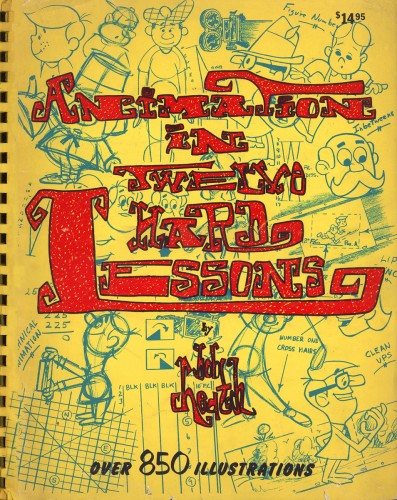 = For the past three weeks, I’ve been posting chapters from the Robert Heath book: Twelve Hard Lessons in Animation.
= For the past three weeks, I’ve been posting chapters from the Robert Heath book: Twelve Hard Lessons in Animation.
The book is an exercise in itself. It includes extremely complicated material mixed with the most basic. It’s an oversized book printed in the most basic way. A plastic binder holds it together and makes it feel like the workbook it is. There are plenty of exercises with the lessons and lots of examples (though these are often drawn pretty crudely) all designed to impart the information they want to get across.
As I’d written in the past, Tony Creazzo was one of New York’s finer Assistant Animators and Bob Heath was a cameraman. Together they make for an odd couple of a pair to author such a book. Yet, there’s no doubt that this material is first rate and there’s a lot to learn from the book they’ve given us.
To read past posts go here for: part 1, part 2, part 3.
We pick up this week with page 68, lesson 9:
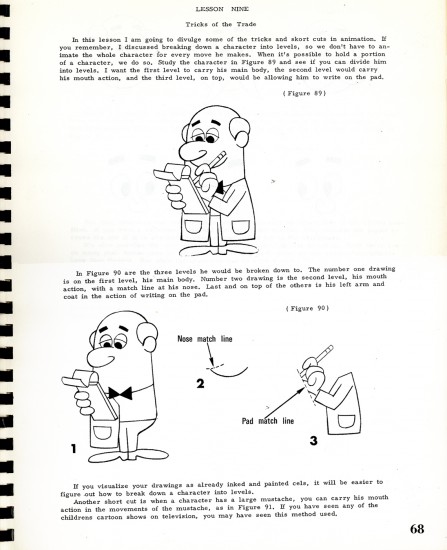 68
68
Commentary &Frame Grabs &Miyazaki 06 Jan 2013 07:02 am
Happy B’day Hayao
- Yesterday was the 72nd birthday of Hayao Miyazaki. Most people found out through his Facebook page. He has a lot of friends. In celebration, I’ve chosen to post frame grabs from one of the most exhilarating film sequences ever made – animated or otherwise. It’s from Ponyo, a film I absolutely love. The treat of seeing it in a theater a couple of times is just a veritable high when this sequence rolls around. Here. I cut it short a bit, since I felt I’d gotten the point across by the 100th frame grab, and it was also a perfect place to cut out.
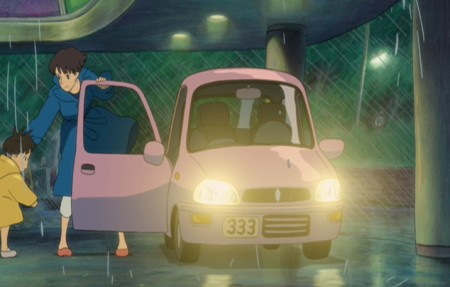 1
1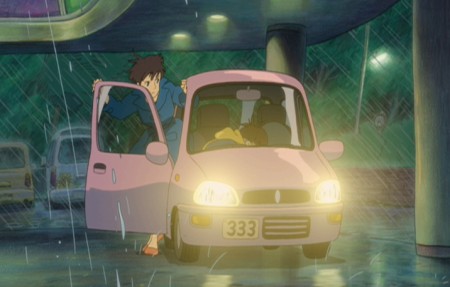 2
2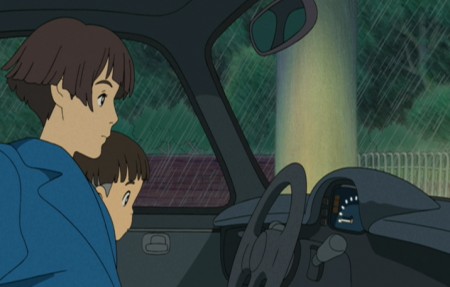 3
3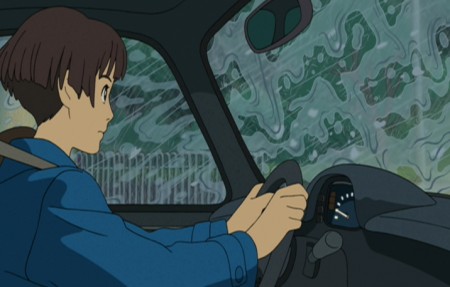 4
4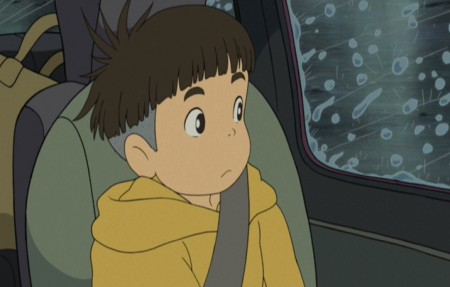 5
5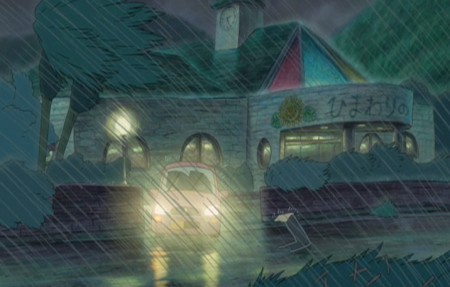 6
6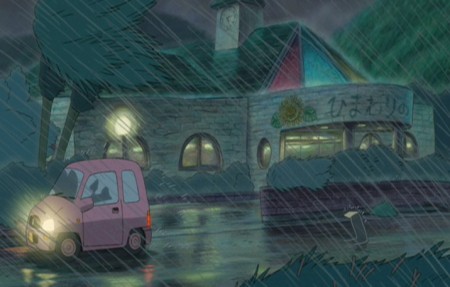 7
7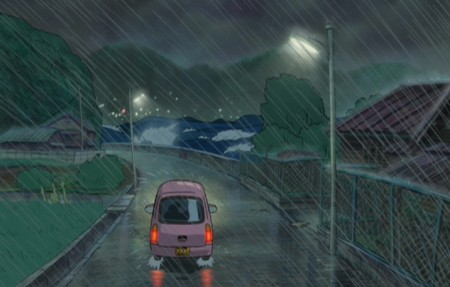 8
8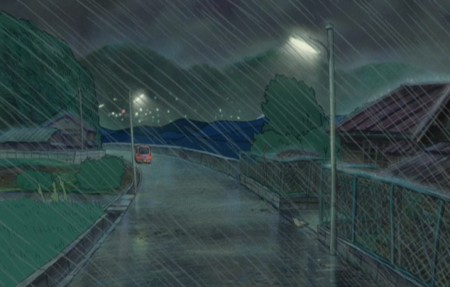 9
9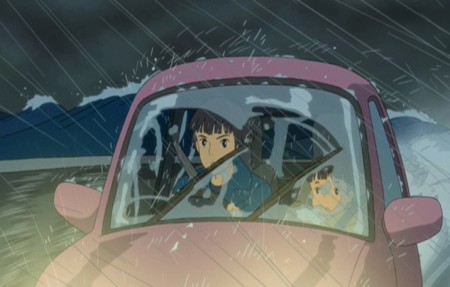 10
10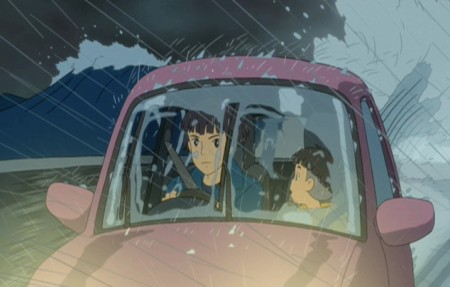 11
11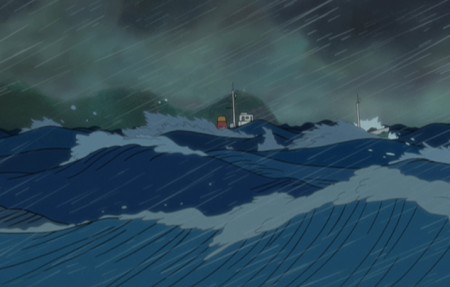 12
12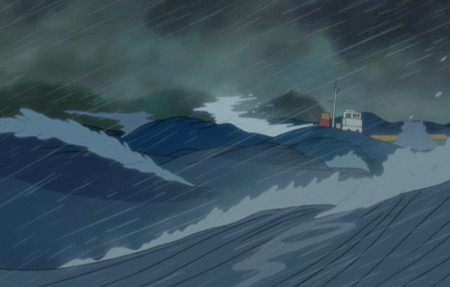 13
13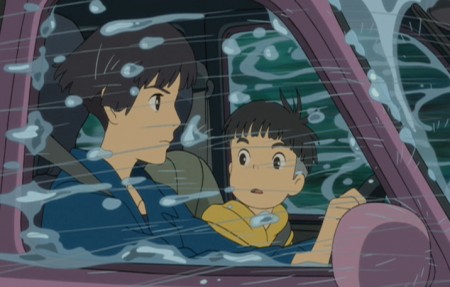 14
14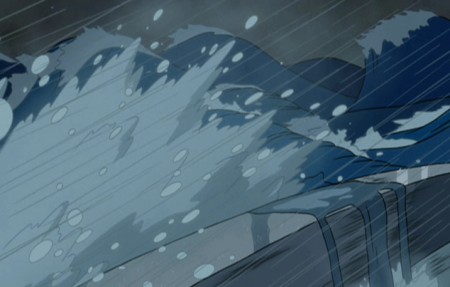 15
15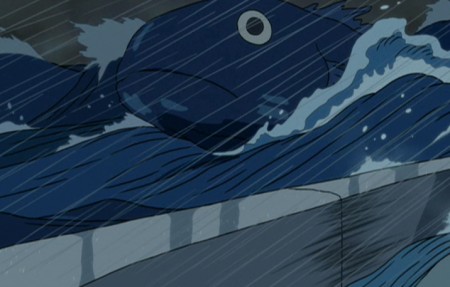 16
16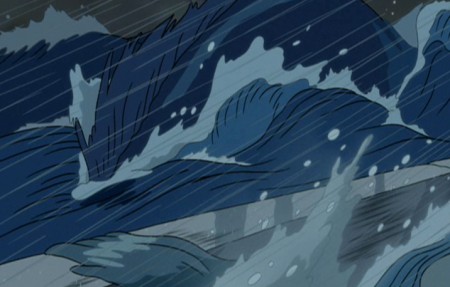 17
17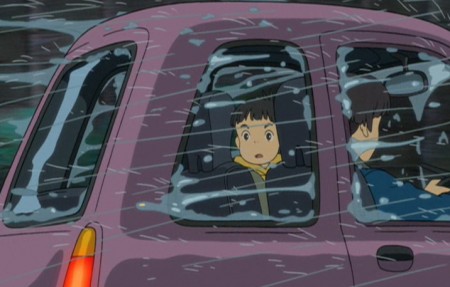 18
18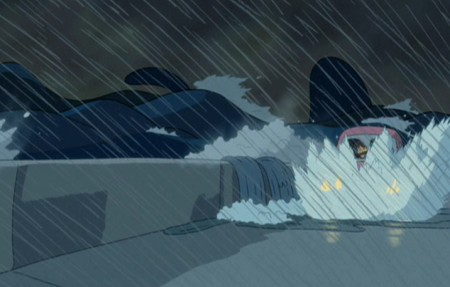 19
19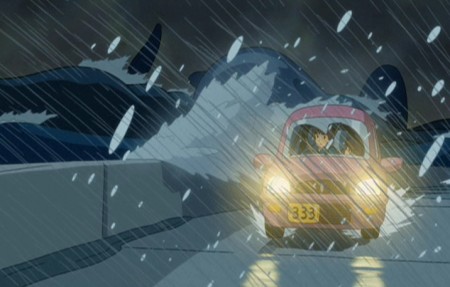 20
20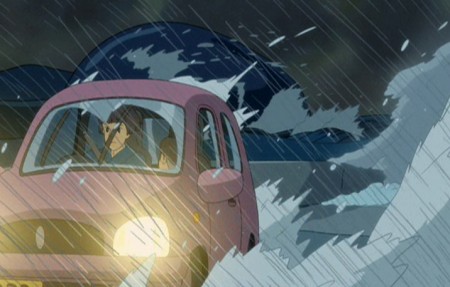 21
21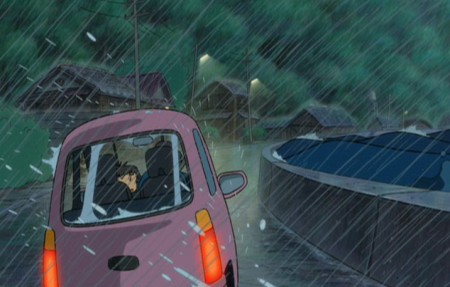 22
22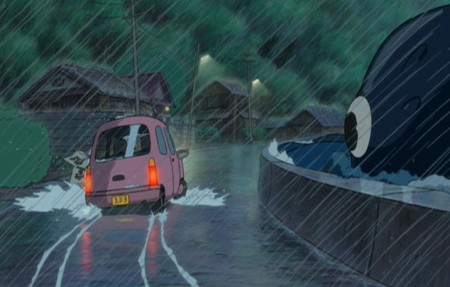 23
23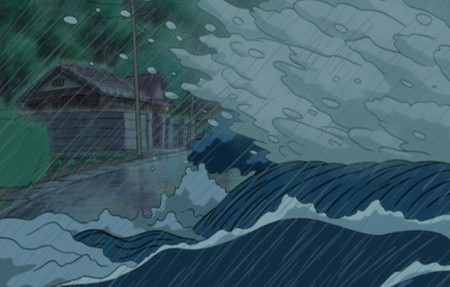 24
24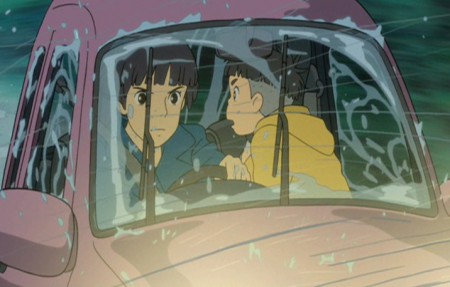 25
25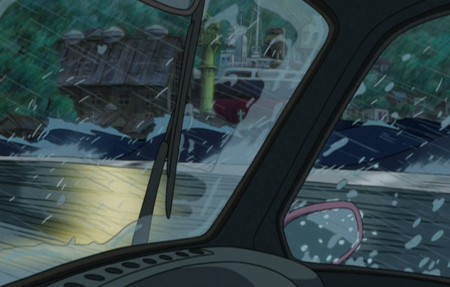 26
26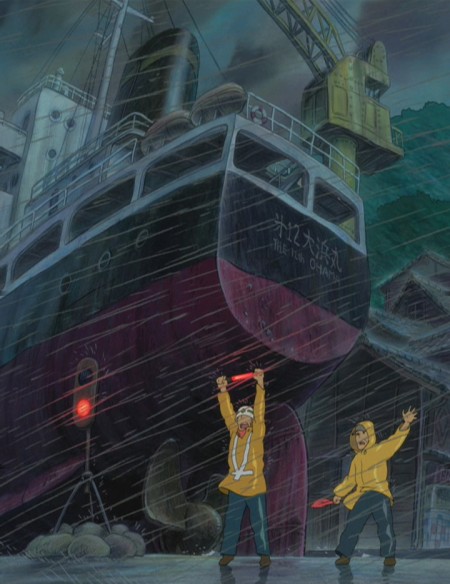 27
27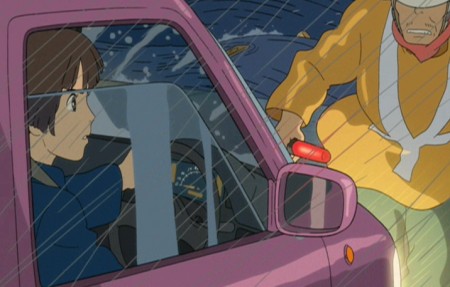 28
28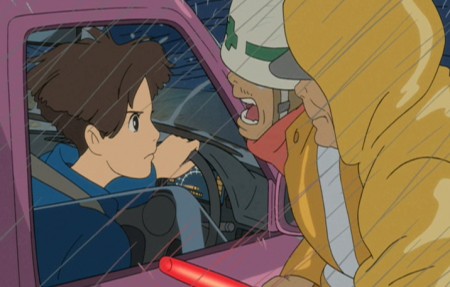 29
29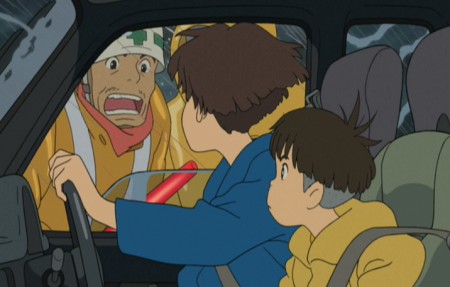 30
30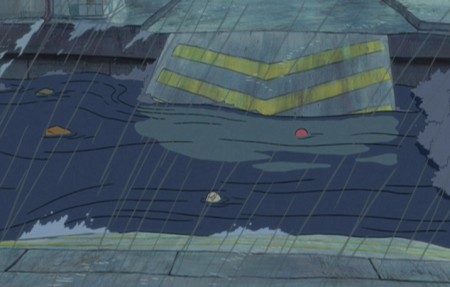 31
31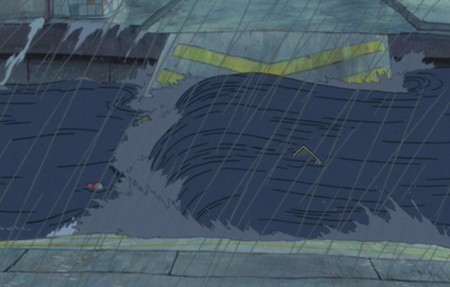 32
32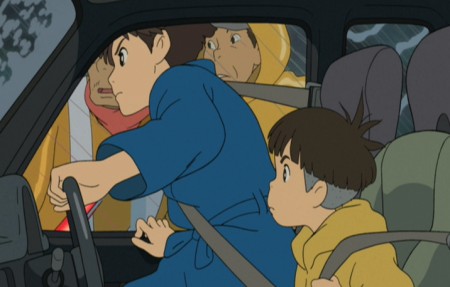 33
33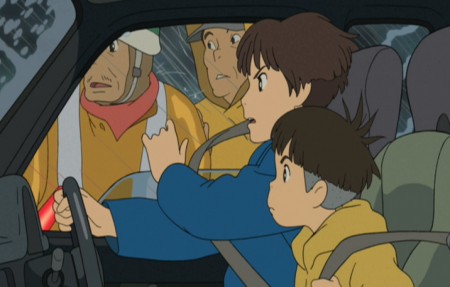 34
34But you can’t go that way . . .
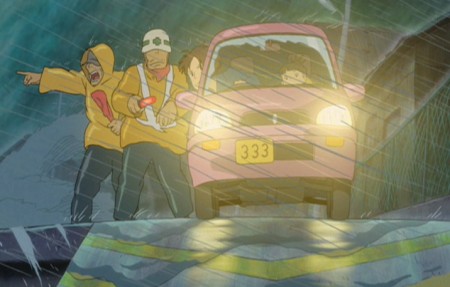 35
35The bridge is out!
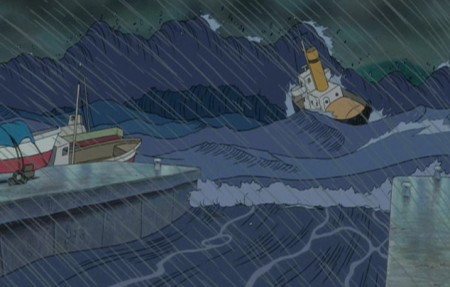 36
36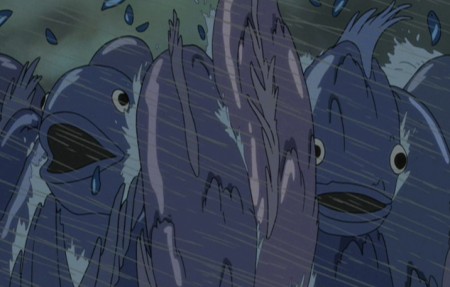 37
37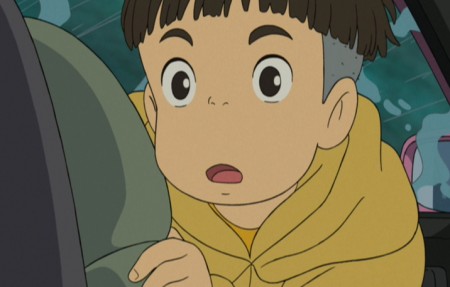 38
38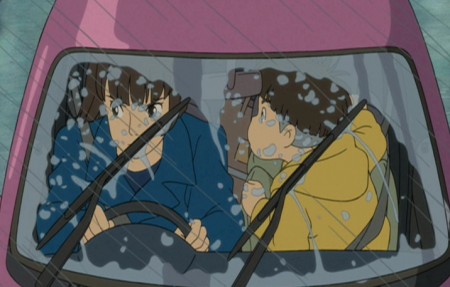 39
39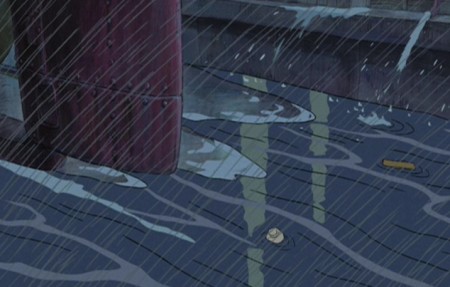 40
40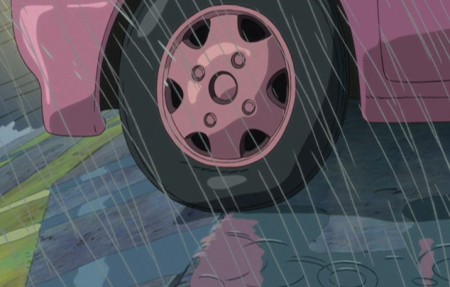 41
41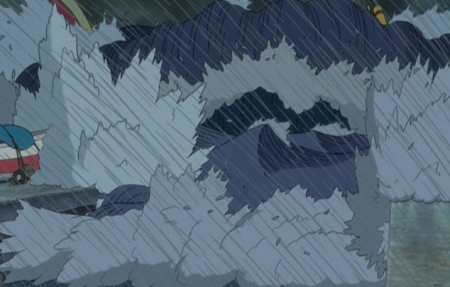 42
42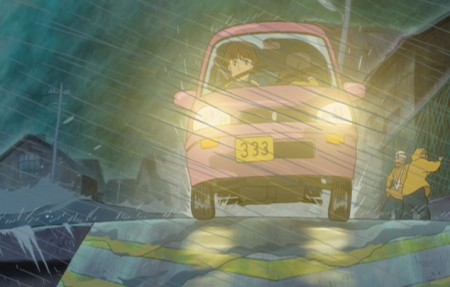 43
43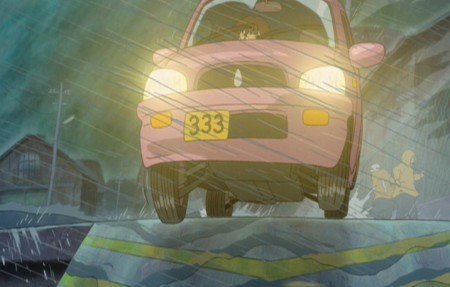 44
44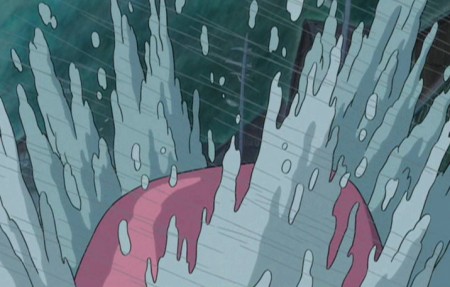 45
45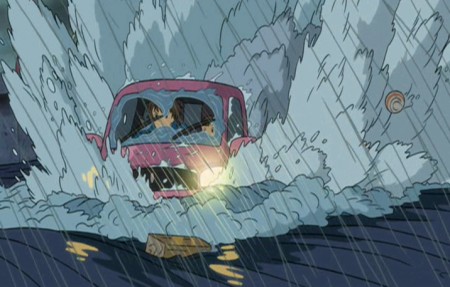 46
46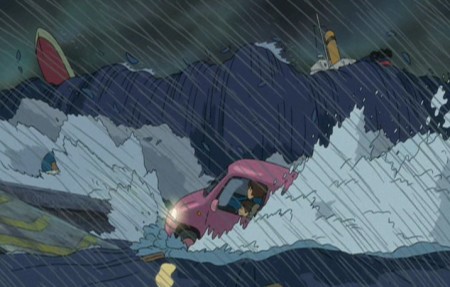 47
47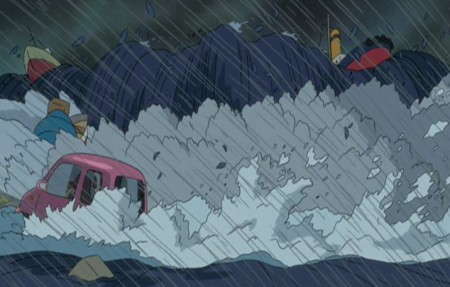 48
48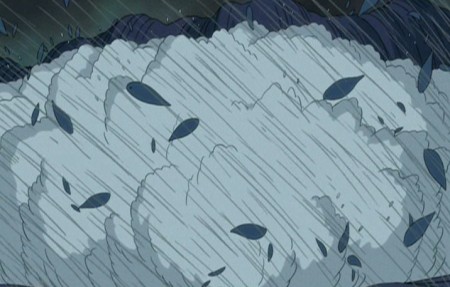 49
49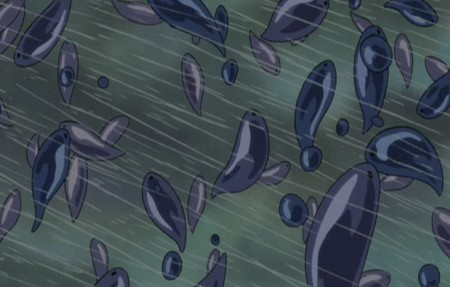 50
50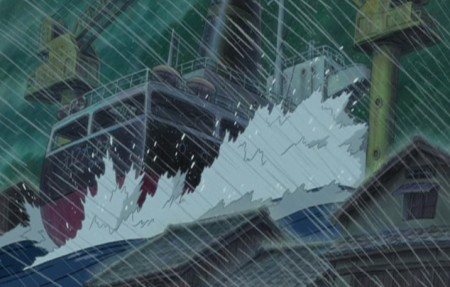 51
51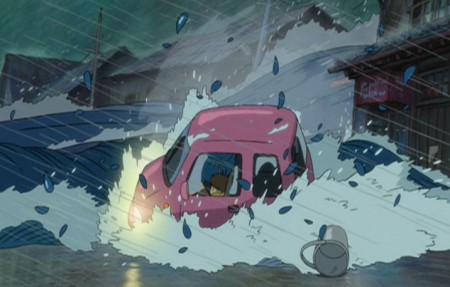 52
52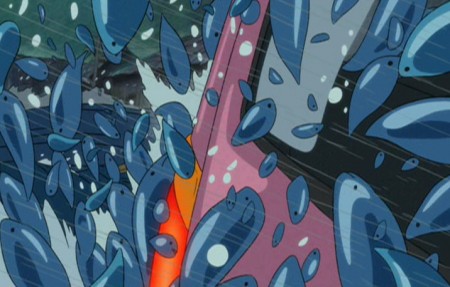 53
53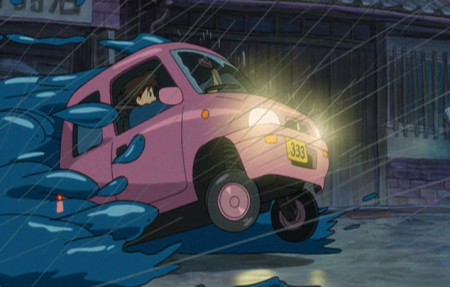 54
54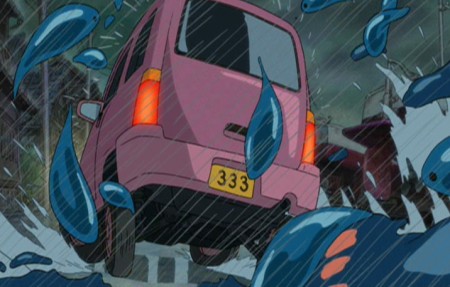 55
55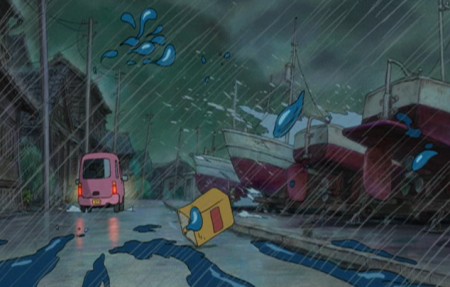 56
56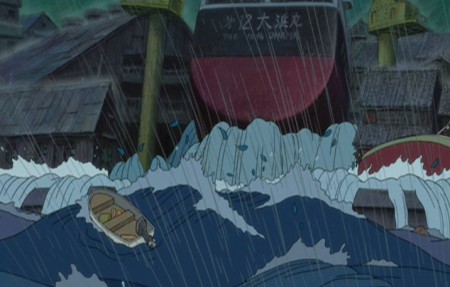 57
57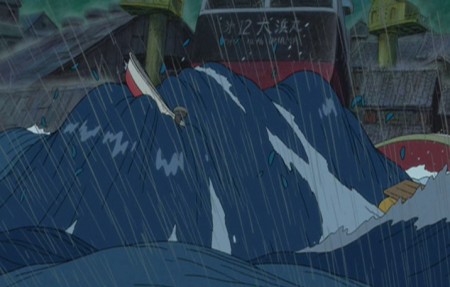 58
58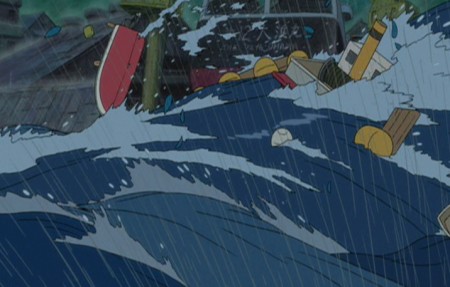 59
59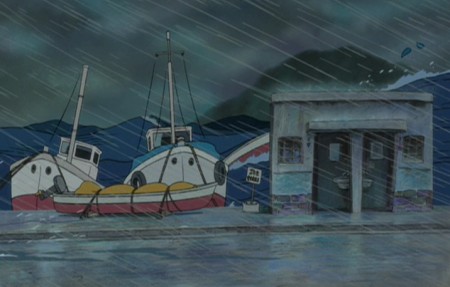 60
60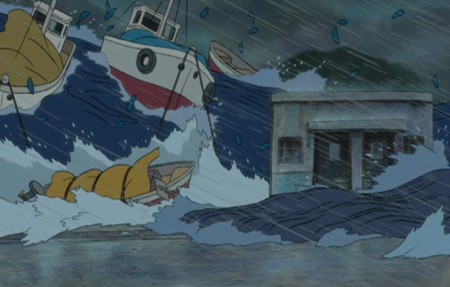 61
61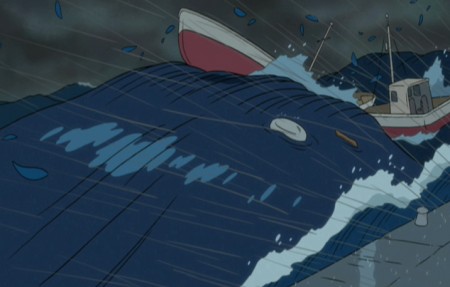 62
62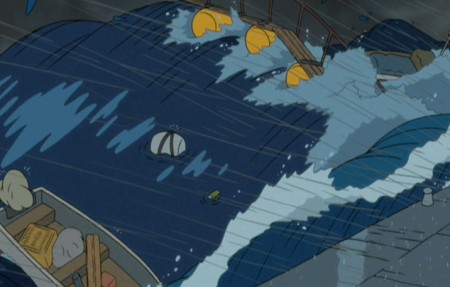 63
63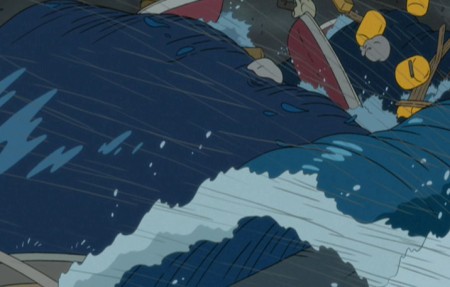 64
64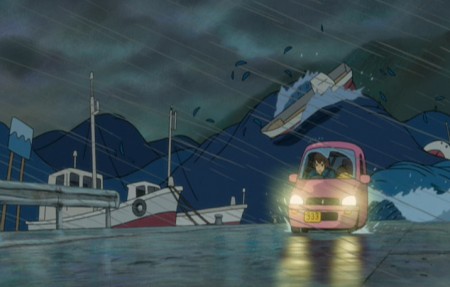 65
65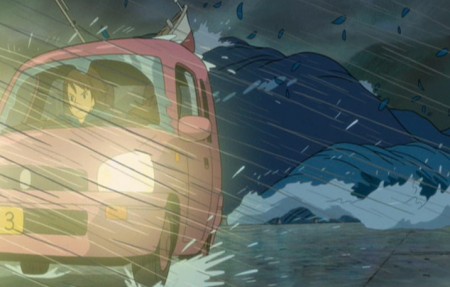 66
66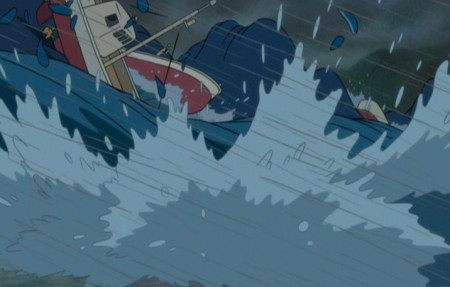 67
67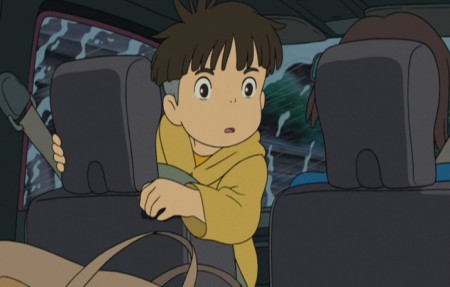 68
68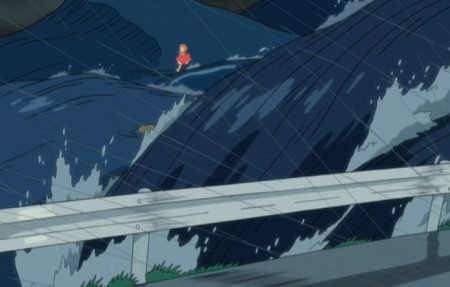 69
69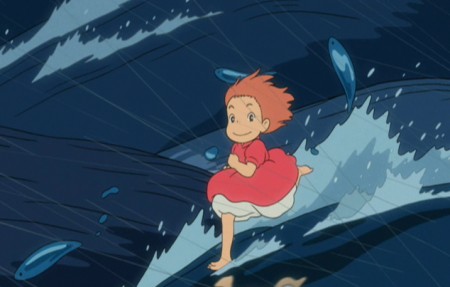 70
70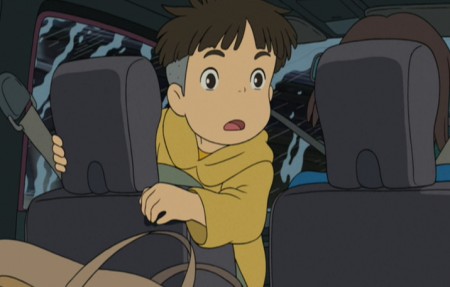 71
71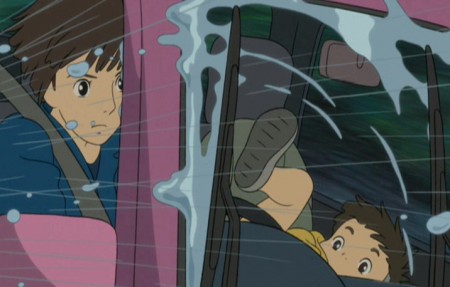 72
72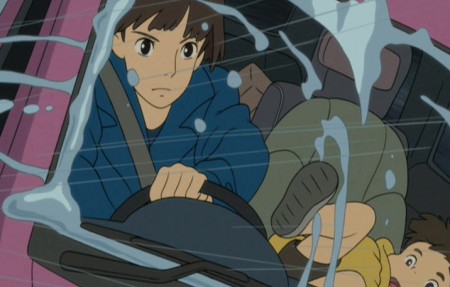 73
73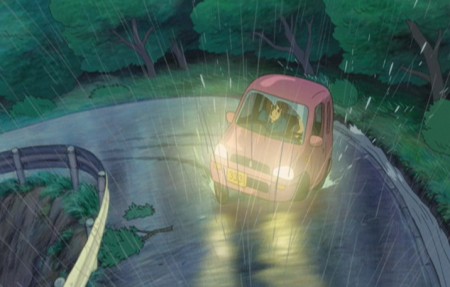 74
74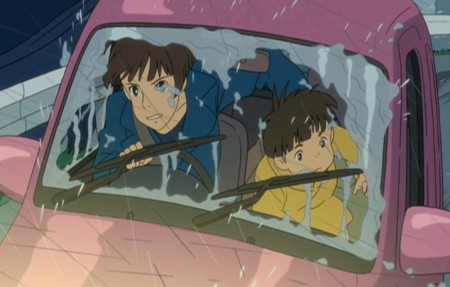 75
75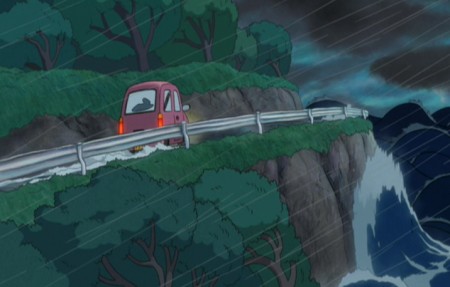 76
76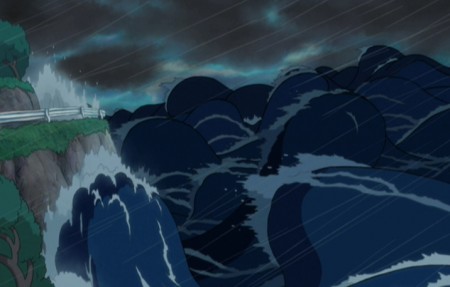 77
77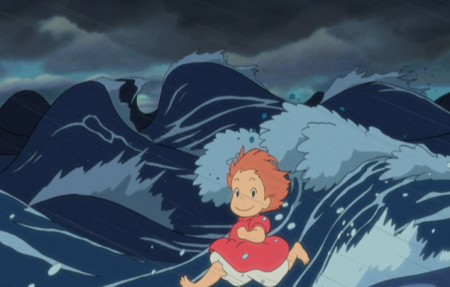 78
78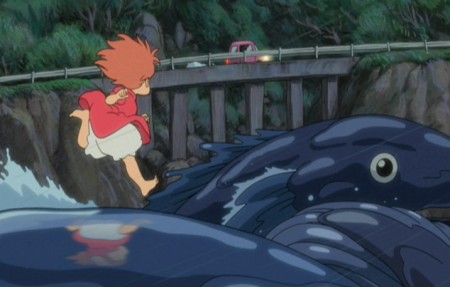 79
79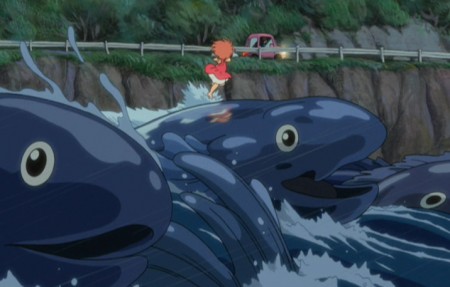 80
80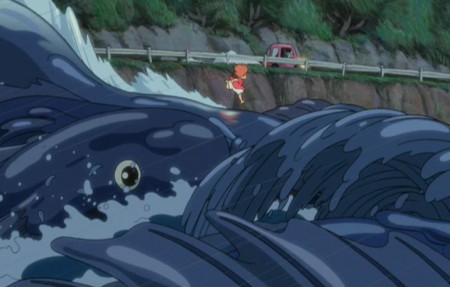 81
81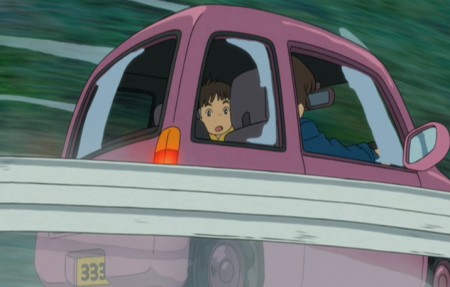 82
82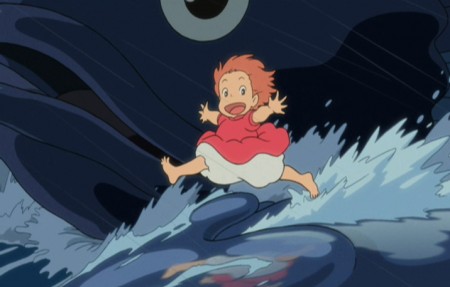 83
83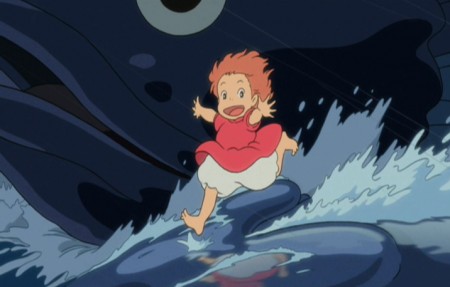 84
84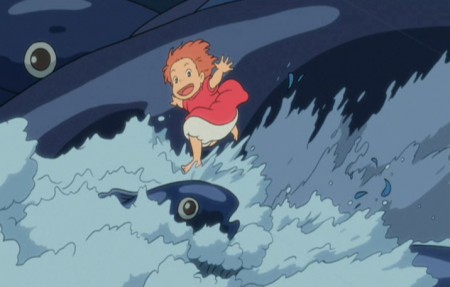 85
85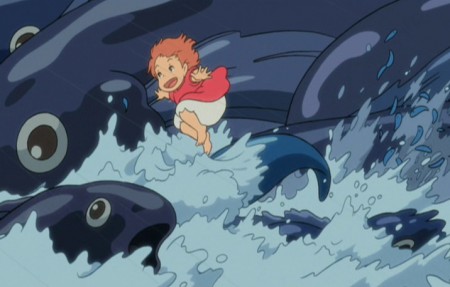 86
86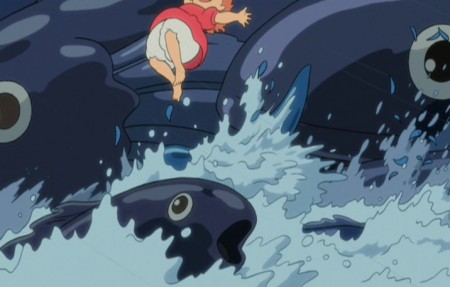 87
87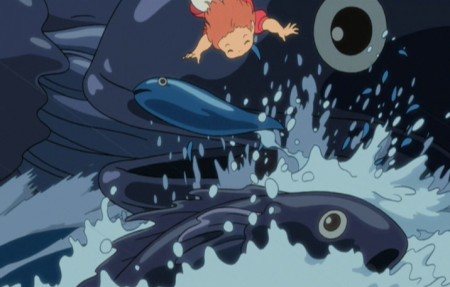 88
88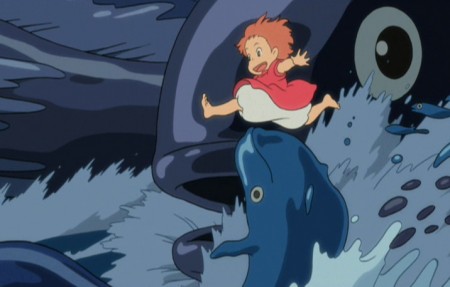 89
89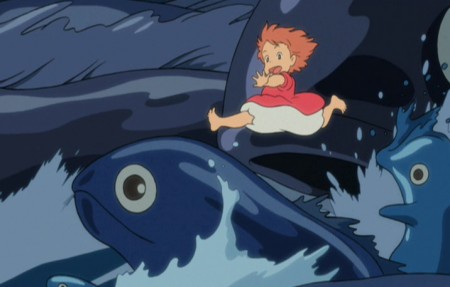 90
90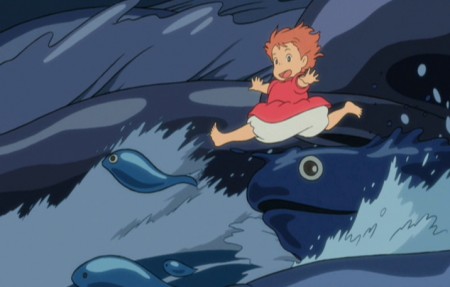 91
91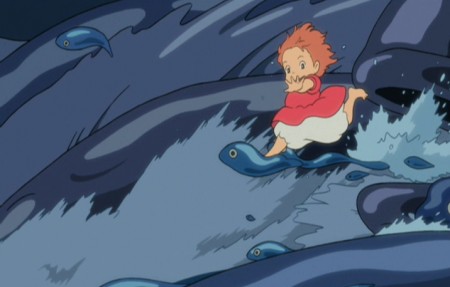 92
92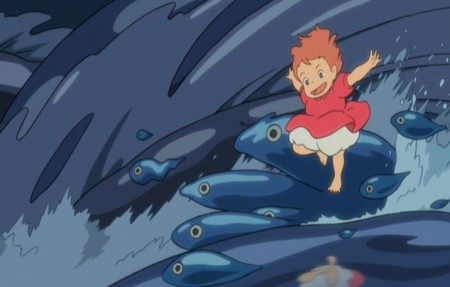 93
93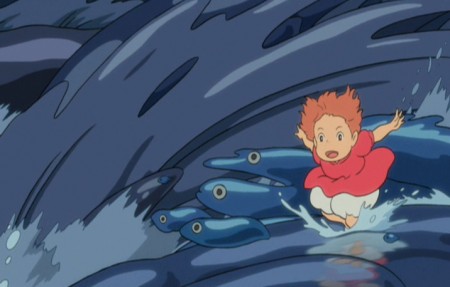 94
94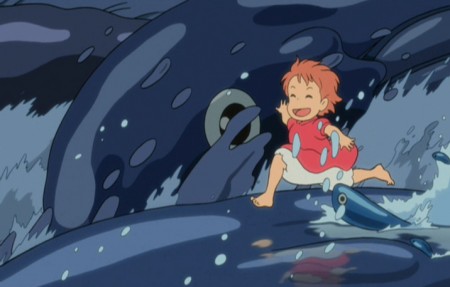 95
95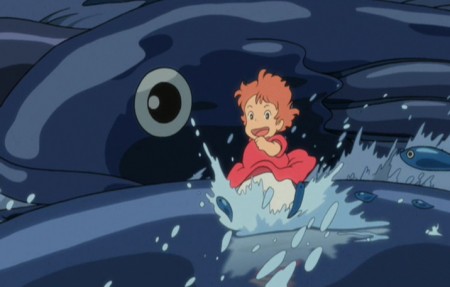 96
96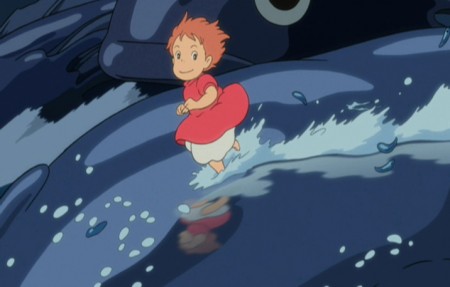 97
97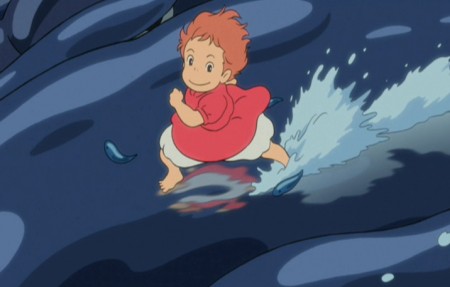 98
98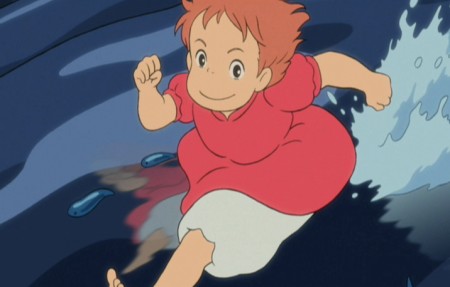 99
99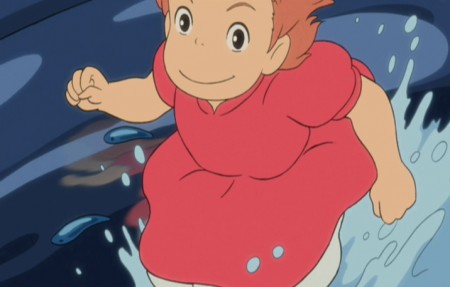 100
100
Happy Birthday, Hayao Miyazaki
Commentary &Daily post 05 Jan 2013 08:20 am
Animator names?
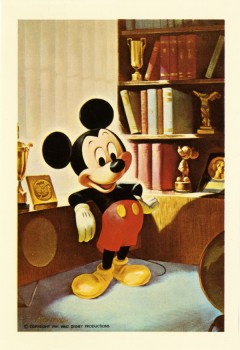 I’ve been an animation fan forever. Back in the fifties (when I wasn’t yet in my teens) I wrote fan letters to Joshua Meador, Bill Justice, and Art Riley. I don’t know if any of them ever received any of my letters, since I always got back a 4″x6″ postcard from Walt Disney thanking me. Mind you, these cards were always interesting and different, so I’m not sorry to have received them.
I’ve been an animation fan forever. Back in the fifties (when I wasn’t yet in my teens) I wrote fan letters to Joshua Meador, Bill Justice, and Art Riley. I don’t know if any of them ever received any of my letters, since I always got back a 4″x6″ postcard from Walt Disney thanking me. Mind you, these cards were always interesting and different, so I’m not sorry to have received them.
In the sixties, Mike Barrier‘s Funnyworld Magazine opened the world to interviews with some real animators. Then you’d start to see similar articles in the likes of Millimeter or Film Comment. Chuck Jones and Tex Avery got lots of attention. I saved and cherished those issues. Hell, I just about memorized them. ASIFA East brought Bob Clampett and a dozen other animators from Yoji Kuri to Frank Thomas & Ollie Johnston to our little New York corner of the world.
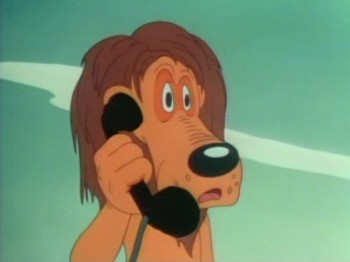 The point is that we got to know who a lot of animators were.
The point is that we got to know who a lot of animators were.
I could tell what scenes Ollie Johnston had done from those that Milt Kahl had done; I can easily identify Bobe Cannon‘s work from Ken Harris‘. (Can anyone but Cannon have drawn with such beautifully rounded lines as can be seen in the lion on the right?
No, that’s purely his work, and it’s there from the earliest right through to Moonbird. Just brilliant!)
{Check out this whole post on John Kricfalusi‘s site in 2006. Gorgeous.}
It became, really, the era of the animator. Many of them were deified by others like me, and deservedly so, even though others remained in obscurity. Watching stars like Dick Williams bring Harris and Hubley and Babbitt to London to train his staff brought fame to the little British studio. Dick soon brought as many famous animators to Raggedy Ann in New York. A star-studded staff assembled, for the first time, for their celebrity and ability and personality. (Star animators rather than star voices. Too bad there was no star writer.)
And Jim Tyer! There’s a whole cult of people who rally around Tyer’s work, and that pleases me. No one I knew, when I was a child, had any idea who Tyer was, but I searched every Mighty Mouse show on Saturday morning TV for a cartoon that had something of Tyer’s work on it. And of course, if you’re going to mention Tyer you have to talk about Rod Scribner. Bob Clampett wouldn’t be the same without Scribner’s scenes. One was East coast, one was West. One distorted the character off all semblance of drawing rules, the other distorted beyond belief (but probably – in his own way – kept the masses the same.)
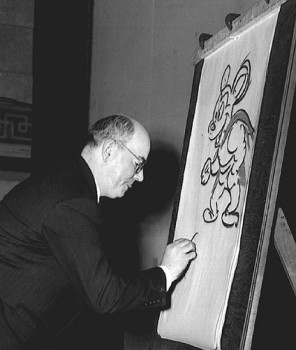
We can all spot his work a mile off.
It’s Jim Tyer
This same rise to fame continued with some of the new guard. Glen Keane and Andreas Deja led a league of youngsters such as Eric Goldberg and Ruben Aquino and many others to small fame within the industry as the new golden era came to the Hollywood studios.
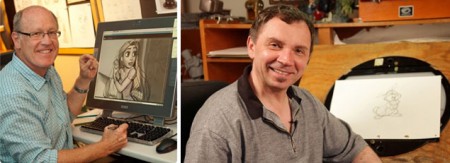
Meed I identify? Glen Keane & Andreas Deja.
Any good student can list off dozens of such names and can tell you what scenes they’ve done. The point that I’m ultimately getting to is that they’re all 2D animation. Where are the cgi lists of names? Where are the heroes from Toy Story and Monsters Inc. Not the directors. We all know who Brad Bird and Pete Doctor are; we know John Lasseter from Andrew Stanton, but who actually did the animation of some of those many scenes.
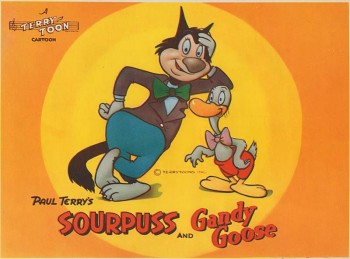 The names are on the credits just as Frank Thomas‘ name is on the credits of Bambi. But I can tell you immediately that Thomas did the scenes of Bambi ice skating, yet I don’t know who did the scene of Woody getting resentful, as Buzz Lightyear gets attention from the other toys. I know that Fred Moore did the scene of Lampwick turning into a donkey in Pinocchio, but I don’t know who did Merida’s mother, Elinor, in Brave. The scenes where the mother is transformed into and acts as a bear are beautifully animated, but the origin of those scenes seem anonymous. I don’t have the slightest clue as to who did them.
The names are on the credits just as Frank Thomas‘ name is on the credits of Bambi. But I can tell you immediately that Thomas did the scenes of Bambi ice skating, yet I don’t know who did the scene of Woody getting resentful, as Buzz Lightyear gets attention from the other toys. I know that Fred Moore did the scene of Lampwick turning into a donkey in Pinocchio, but I don’t know who did Merida’s mother, Elinor, in Brave. The scenes where the mother is transformed into and acts as a bear are beautifully animated, but the origin of those scenes seem anonymous. I don’t have the slightest clue as to who did them.
Grayson Ponti is one of the few who have sites that have praised some excellent cg work, and I can’t be thankful enough for his attention. Check out this post for a sample, but that was written a couple of years ago. We need more frequency and more currency.
I’ve made this complaint before. I talked about Glen Keane‘s work and got lots of hate mail. I said I was trying to learn who did which scenes so that I would know the better animators from the average ones. There were a couple of people who commented on my site and led me to a name or two. But not much changed, not really. I’d very much like it if some of you would comment here and tell me of animators I should be watching. Give me names of people who you think have done some brilliant work in cg films. Tell me the animator, tell me the scenes and I’ll try to offer some appropriate attention.
I don’t have access into the world of the cg artists and animators. I do know a few 2D artists who are working within that world, but it’s the animator who works exclusively in the medium I want to notice and give a little attention to. I need your help. I cannot do it if I don’t know who those animators are at Pixar, Dreamworks, Blue Sky, Disney, Sony and other places. If I don’t know their work I can’t give them credit.
Honestly, for me this year the best animated scenes were many of those of Richard Parker in The Life of Pi. Rhythm and Hues did the work.

This scene knocks me out every time I see it. Pi is trying to
train the tiger, Richard Parker, and the tiger kneads the wood
of the boat (as any house cat would knead a blanket or its
owner, while accepting the comments of his teen overseer.
I’ve contacted the EFFX house offering to give them any attention on my Blog that they’d like from me. Publicity is publicity. (Of course, there’s been no response, surprise, surprise.) Regardless I’m going to continue promoting this film. I love it. But I’d like to add animator names and key art people responsible for the great work. I need them to contribute to get that part right.
I was also equally astounded by most of the work of the Gollum in The Hobbit. One is straight cgi; the other is what used to be called “motion capture” and is now something much much more. There’s real feeling in both those films, and in both those films those characters exist. There can be no question of it.
Now, I’d like to know who is actually doing the creative work. behind the Pixar, Blue Sky and Dreamworks films. I want to talk with people from SONY or other studios. I have a lot of questions and I want to give focus to some individuals who deserve it.
Curran W. Giddens worked on Horton, Cars 2 and Monsters University. What can he tell me about animation?
Raffaella Filipponi worked on The Croods, Shrek and Over the Hedge. She’s freelanced a lot and is that how theses studios work?
Dave Hardin worked on I am Legend, Alice in Wonderland and Turbo. Can he learn the “art” part moving from job to job?
These people were chosen at random. I don’t know their work even though I’ve seen it. Is there a point when THAT will turn around? Do you have to keep on the move to keep working? Is it time to start promoting responses? We’re not working at Disney on a 15 year job that allows you to move from feature to feature without it hurting you attitude, never mind your work?
Perhaps you think (as I sometimes suspect) that no single person can be given credit for “animating” since so many people have their hands on the steering wheel trying to move those characters forward. If so, say that. If you think there’s a team of people that work wonderfully together, I’d like to know. Essentially, I’d like your help continuing this post. If you don’t want it to be in the comment section of this article but would like to add to the follow-up post I’m going to do, email me. msanimation@aol.com is the best address; it’s the place I check most often. Write as short or as long as you like. If I have to edit it I will, and I’ll let you know when it’ll be posted so you can see it as soon as possible.
Commentary &Independent Animation 04 Jan 2013 08:35 am
Combustible Shorts
 - Having seen most of the films in the Oscar race, I have a lot of thoughts about many of them, most particularly some of the animated films. Not the features, I don’t really have much to say about cgi films except that I wasn’t crazy about any of those I saw. There was a lot I really enjoyed about Brave, but that wore away over time, and I now find it hard to watch again on DVD. I will before the final vote.
- Having seen most of the films in the Oscar race, I have a lot of thoughts about many of them, most particularly some of the animated films. Not the features, I don’t really have much to say about cgi films except that I wasn’t crazy about any of those I saw. There was a lot I really enjoyed about Brave, but that wore away over time, and I now find it hard to watch again on DVD. I will before the final vote.
A couple of the animated shorts have really dug into my mind, and I’ll try to comment on them before the nominations come out. The film that was entered that haunted me most was a puppet film called Oh, Willy!, but that didn’t end up on the short list, so I’ll wait to see it again at some Festival screening.
Of those on the short list, only one seems to be by a genuine Master of the medium. Otomo Katsuhiro deserves more than a little respect in that he’s made several giants in the Japanese Anime medium. AKIRA (1988) was considered a classic when I was told about it in the early 90s. I made many attempts to get through it, but had problems following the film’s story and gave up at least five times. There was no doubt that enormous work and craftsmanship went into the making of the film, with its unusual angles and forceful drive. Every scene seemed to be overwhelmed with activity, and so much came at me that I pulled away.
Otomo was a writer on the film, MEMORIES (1995), which I was quite taken with. It didn’t have the heart of Myazaki, undoubtely my favorite Japanese director today, but there was quite a bit to enjoy there. I’d like to see it again and look closer at Otomo’s sections. In 2004 he wrote and directed the enormously respected STEAMBOY. This film, like others he has directed, is stunningly produced with enormously gifted graphics, but I tend to find myself unable to emotionally connect with its characters and story. There was much less of a problem than I’d had with AKIRA, but it didn’t wholly connect to my taste.
This year we have the extravagantly attractive and completely alarming 12 minute short, COMBUSTIBLE. I don’t for the life of me see how this film could be left off the nominee list, so I want to write about it before those nominations come out. I haven’t met an animator, yet, who hasn’t praised the craft of this film to the hilt. Yet. again, it seems to be an emotional thing that affects many I’ve spoken with. This film does speak to me with its pent up feelings and hidden emotions ready to combust at any moment.
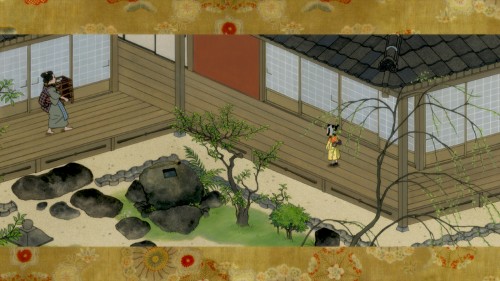
The courtyard leads from the unravelled scroll into
the claustrophobic home with pent up emotions.
The movie starts out with a slowly moving scroll that unravels for us and we begin to pan down the very long image until bits of it start animating. Then the first big sequence grows out of the scroll. We see two children, neighbors, as they play with and around each other. It’s all played out in long shot on that scroll – an extension of that first image, above, and it isn’t always certain what their game is. We do realize that both the boy and girl are close with each other and grow up that way.
We learn that the two are separated by their parents, especially the girl’s father. The boy is all but disowned by his family as he has developed a passion for a career as a fireman. We see this when a nearby fire breaks out, and the perishable buildings immediately ignite.
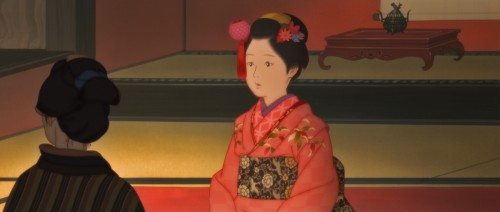
The girl is made to behave as her middle class society demands of her.
The girl’s father has no kindness for the boy, and often throws nasty comments and remarks his way, at one point degrading him for getting a large tattoo. The boy has marked himself with a fireman’s imagery, and he runs away to become one. The girl’s father plans to marry off his daughter to a suitor, though there is no doubt she is in love with her childhood friend, who has left her.
To me the key scene in the film shows the girl, alone in a room, bored, throwing paper fans to fly in circles about a room. One accidentally falls on a lantern, and slowly ignites. The girl, at first, races to get help, but ultimately stares with a thrill as the lantern burns and other objects in the room catch fire.
This fire, I’ve learned is ased on historic incidents. The Great Fire of Meireiki which was also known as the Long-Sleeved Kimono Fire and the Great Fire of Greengrocer Oshici were similar fires of the time. The secret love affair ends in flames, but the film glows with strength of this love and other hidden emotions. Something I have no doubt which is close to the author, Otomo.
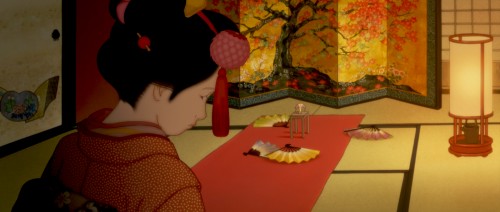
The girl, from her POV, throws fans circling about the room.
Her ennui takes form in these fans, searching for that flame.
As I said the film’s life burns with a fury during the sequence in which the heroine accidentally lights the great fire, and her emotional games wreak havoc in many homes, hers included. Although her love tries to save her, she ultimately dies among the flames. The tedium on her face as she throws the paper fans shows all the hidden and pent up emotions within her. The fire she starts brings out an excitement as she realizes her one love will return to try to save her. He does and comes close to achieving the happy ending for her.
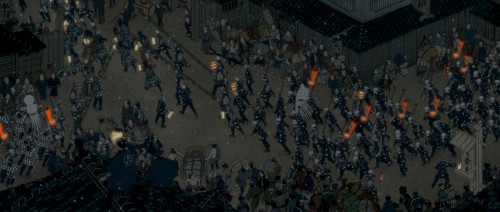
Crowds of firefighters descend upon the city as the flames
immediately burst into a violent and dangerous fire.
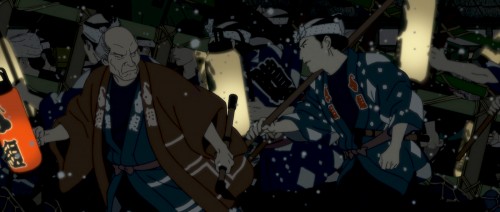
They work out of the darkness of the night with
the light of the fire burning against them.
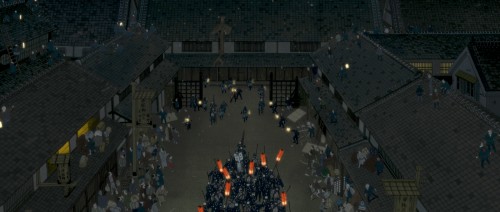
I’m not sure of the exact order of these scene, these images were
sent to me and Ive assembled them in the numerical order they came.
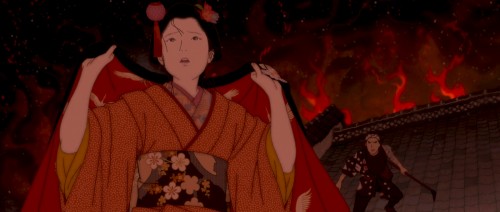
Finally, the girl hears her love come to save her.
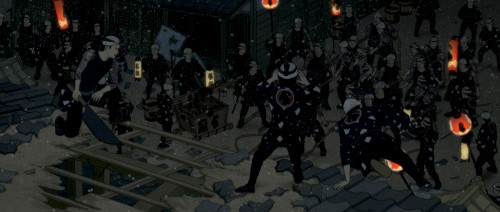
He has been placed in charge of separating and destroying the
building that is the fire’s center. The girl’s house and his own family’s.
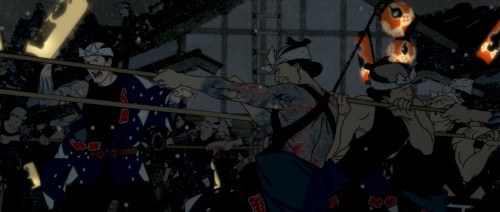
He goes at his task methodically and swiftly.
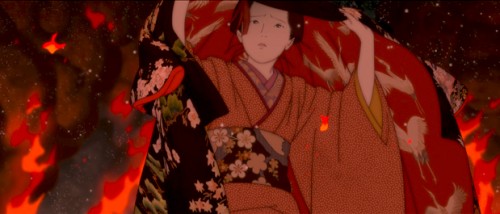
Unfortunately, the girl does not know his plan and she moves directly into the fire.
This is a complex story told in a very complicated way, and the techniques of animation must employ every beat to pull it off. Otomo has the craft in hand and works hard to relay the story. He adds many aspects of his own culture to wash into the sory driving home the realism of the story.
His normal difficulties in having characters who properly emote, at least for Western audiences, seems to be employed to add to the emotional thrust of the story. It’s a very well executed short film and firmly acts like a great short story bringing so much to a short slice of a tale. The tale of a culture and the people who not only make up that culture but act out in history.
It’s one of several excellent films on that short list this year, and I look forward toward seeing the nominees that will be chosen.
Animation &Animation Artifacts &Independent Animation &walk cycle 03 Jan 2013 07:58 am
Picasso
- When you run a studio in New York, and you’re an animator, there’s a good likelihood that at the quiet moments when work is slow, you’ll be working on your own bit of animation. Whether it’s a short film or a test of something you’ve always imagined animating, it’s hard not to keep pencil to paper (or stylus from the Cintiq.) Vinnie Cafarelli was just such a creature. After seeing a show of Picasso’s works he took the flier and started animating the image Picasso had done. It never got to completion; those were the days of the expensive cameraman and laborious cel process. But I can take Vinnie’s work and finish it in AfterEffects and Photoshop. Here’s my exosure of his basic animation. No X-Sheets were left behind. Here’s the art; here’s the QT movie.
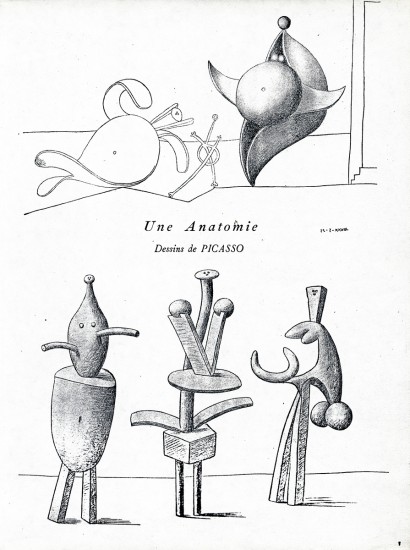
This is the original flyer that got Vinnie going.
He built all his animation up from this printed piece.
The “character” drawings follow:
The following QT movie was made of the
drawings above. Since there were no X-Sheets
For better or worse, I came up with the timing, myself.
Animation Artifacts &Books &Commentary 02 Jan 2013 09:07 am
Guernica Eyes
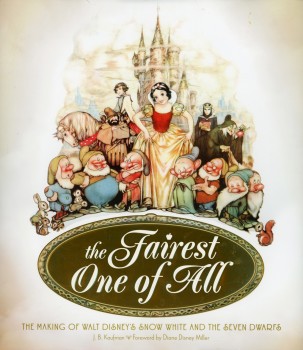 - I received a number of wonderful gifts this Christmas. Among them, from Heidi, came the two – count them, two – J.B.Kaufman books: Snow White and the Seven Dwarfs: The Art and Creation of Walt Disney’s Classic Animated Film and The Fairest One of All: The Making of Walt Disney’s Snow White and the Seven Dwarfs . Receiving one of these two books, both of which are expensive, is a luxury and a great gift to be treasured, but to receive both is above and beyond the treasure category. This is beyond the hoped for. And of course if you were asked to give the “list” of hoped for books, you feel guilty just requesting them. One of these books is expensive; the other is VERY expensive. Together, it’s outrageous. Unless, of course, you’re Mitt Romney’s child.
- I received a number of wonderful gifts this Christmas. Among them, from Heidi, came the two – count them, two – J.B.Kaufman books: Snow White and the Seven Dwarfs: The Art and Creation of Walt Disney’s Classic Animated Film and The Fairest One of All: The Making of Walt Disney’s Snow White and the Seven Dwarfs . Receiving one of these two books, both of which are expensive, is a luxury and a great gift to be treasured, but to receive both is above and beyond the treasure category. This is beyond the hoped for. And of course if you were asked to give the “list” of hoped for books, you feel guilty just requesting them. One of these books is expensive; the other is VERY expensive. Together, it’s outrageous. Unless, of course, you’re Mitt Romney’s child.
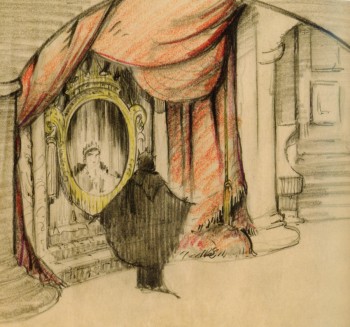 So I received both. I It was like having the Squid AND the Whale in my house, and I spent the day, in between Christmas outings, fingering both books delicately. I’d seen the less expensive book, Snow White and the Seven Dwarfs: The Art and Creation of Walt Disney’s Classic Animated Film, on a couple of different occasions. It’s beautiful.
So I received both. I It was like having the Squid AND the Whale in my house, and I spent the day, in between Christmas outings, fingering both books delicately. I’d seen the less expensive book, Snow White and the Seven Dwarfs: The Art and Creation of Walt Disney’s Classic Animated Film, on a couple of different occasions. It’s beautiful.
The other book, the one that costs almost twice the price of the first, I’d seen that book on a table – away. No copies. That made me want it all the more. It’s the book that has more of the writing in it. And that’s what I want – the words, the history. Those images are glorious, but the thoughts and ideas of Kaufman and others he’s investigating are the stuff I search for today.
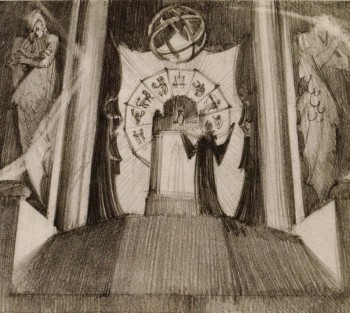 I started digging into and reading this second book: The Fairest One of All: The Making of Walt Disney’s Snow White and the Seven Dwarfs , and there were no disappointments here – not yet. As a matter of fact, it’s to the contrary.
I started digging into and reading this second book: The Fairest One of All: The Making of Walt Disney’s Snow White and the Seven Dwarfs , and there were no disappointments here – not yet. As a matter of fact, it’s to the contrary.
In the rear of the book, “Section Four: Production Notes,” Kaufman breaks the film drafts down verbally. Scene to scene, cut to cut we read who the directors are, who the animators were as well as their key Assistants. And the Effx Animators as well as the Asst Directors.
Funny how I thought, just now, how these last 3 names are less important than others. I don’t know why or if I really believe that. The information is there to disprove it one way or the other. This is a fine little section of the book. It gives real homage to the people behind the glorious animation of this film. Maybe someday we’ll be able to figure out who did which background. Take a look at that scene of the Queen sitting on her throne. Why is there no record of who was involved in painting that amazing backdrop? I seem to remember Maurice Noble talking about the scene, but I don’t have the verification to back up such a claim. I’m not a historian; I just have a faulty memory. All we have is whatever information the Disney archives can tell us. If they were able to tell us anything, Mr. Kaufman most certainly would have taken the information to print.
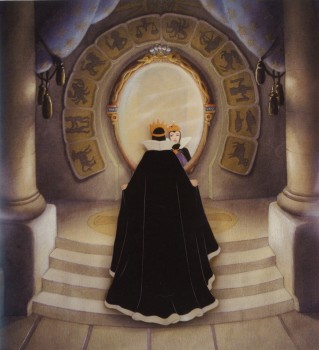
The Queen at the magic mirror. Note the astrological
signs surrounded the mirror from the very beginning
- see above preliminary drawings.
I’m not going to review the two books here; I haven’t really read them and can’t do that. I do know that they’re great books; you can sense it, see it, feel it, smell it. Snow White’s a seminal film for me. I get a thrill whenever I see some of the scenes from this movie, and I’m always hooked on it. The two books will keep me busy and help to let me feel the reason I love animation.
Truth be told, I can’t imagine anyone giving me more information than Mike Barrier did in his book, Hollywood Cartoons: American Animation in Its Golden Age. Or again he did it in The Animated Man: A Life of Walt Disney. The writing in those books is brilliant, but so, too, is it great reading in Kaufman’s books. The story by Barrier is complete, and I’ve already read both of his books half a dozen times, each. These two Kaufman books will keep me busy, and I’m happy for that. I’m sure the story will be more than complete here, too. I don’t know if there’s any more to learn, but I somehow suspect we will have a new view. At least I have good reason to believe so; I know I’m in the hands of a good historian, and I don’t expect to put these books down.
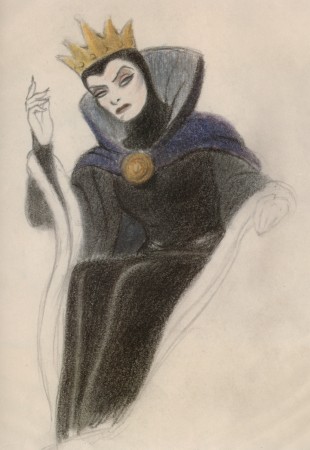
The Queen on her throne -
ah, there’s a background!
But I’ll save that for the real review.
By the way, don’t ask me why I called this post the heading I chose. Guernica Eyes. It seemed to fit, especially with that last Joe Grant drawing I’ve displayed. An amazing talent in a studio filled with amazing talent. When you see some of the art he did for Snow White, you can have no doubt of that. (As if you would after reading John Canemaker‘s Two Guys Named Joe.
